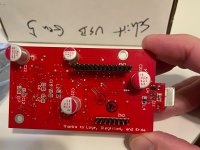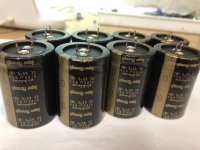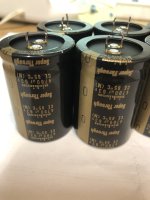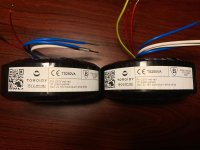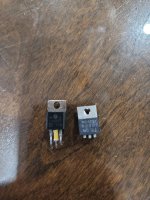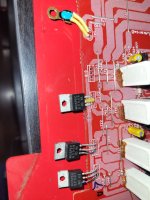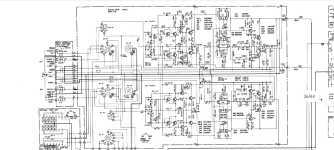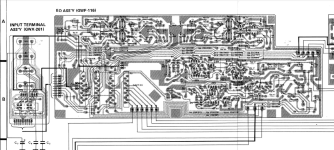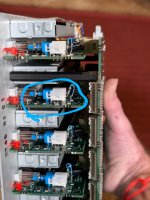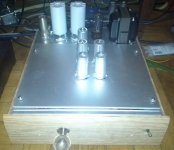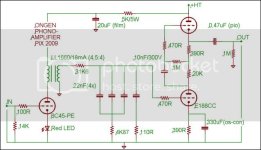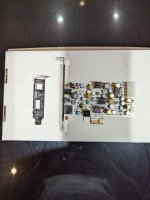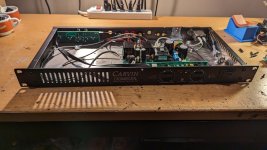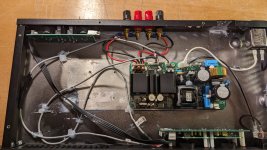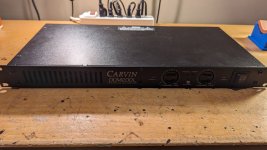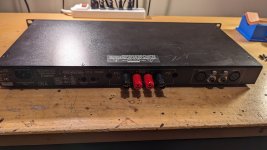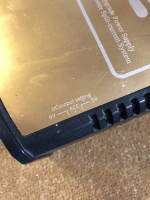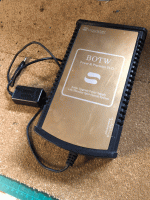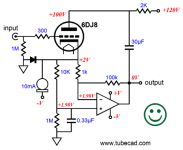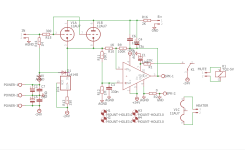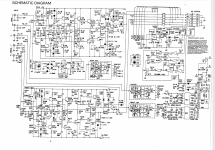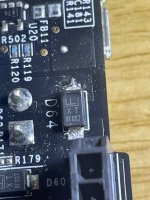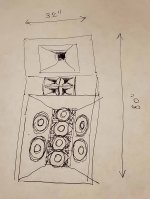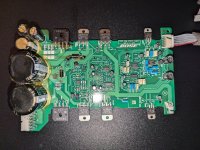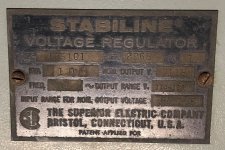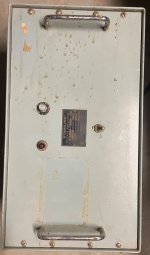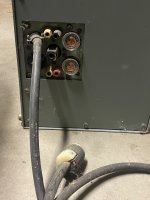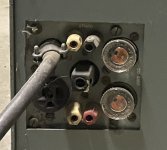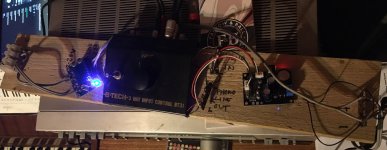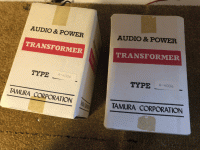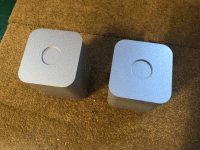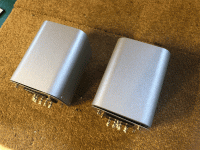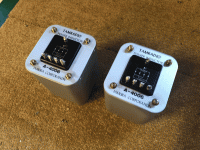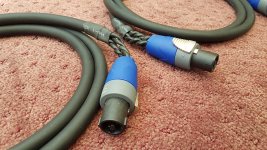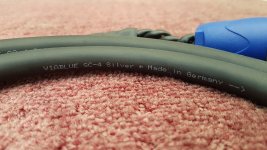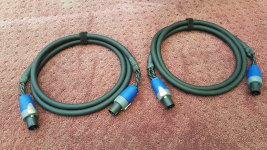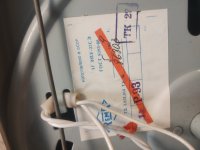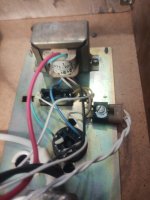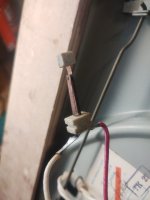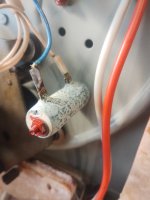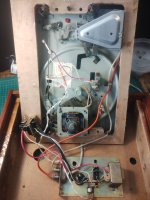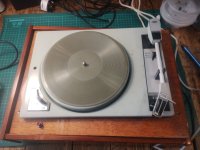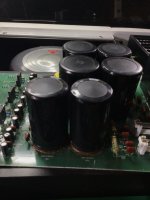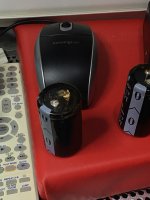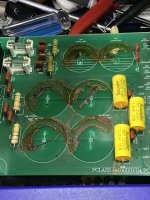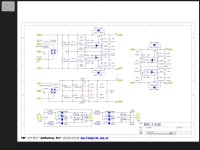You are using an out of date browser. It may not display this or other websites correctly.
You should upgrade or use an alternative browser.
You should upgrade or use an alternative browser.
Filters
Show only:
For Sale Edcor XPWR178 Power Transformer
Edcor XPWR178. Leads appear new / unsoldered.
Bought here years ago for project that is no longer on radar...
Spec sheet:
Edcor XPWR178
$85 shipped Conus
Bought here years ago for project that is no longer on radar...
Spec sheet:
Edcor XPWR178
$85 shipped Conus
Attachments
Phono preamp from the LT1115 datasheet
- By luis.martins
- Analogue Source
- 56 Replies
Hi all,
I would like to build the phono preamp from the LT1115 datasheet, the schematic shown on the first page of the document. This will be used with a Dynavector 20X-L (.3 mv - moving coil cartridge).
I have a few questions about the circuit:
The 2N4304 FET used to bias the LT1115 output in class A is no longer available, which component could I use to replace it? what about replacing it with a current source diode like the 1N5305 or even using a LM334 adjustable current source.
If I change the FET how can I calculate the value for the resistor in series with it? I can always go by trial and error... 🙂
Which component would be the best option in order to keep the noise level as low as possible.
What is the purpose of the 3n9 capacitor connecting the output to the ground? What about the 25K resistor marked as RL?
There is no coupling capacitor in the output of this circuit, should I add one, or is this not necessary with this topology.
What is the purpose of the 2200uF and 4.7uF (film) caps in parallel that connect part of the feedback loop to the ground?
Can I power this with +12 / -12 instead of 18 volts? what would be the drawbacks? If 12 volts is possible I could try to power it with batteries....
Thank you in advance,
Luis
I would like to build the phono preamp from the LT1115 datasheet, the schematic shown on the first page of the document. This will be used with a Dynavector 20X-L (.3 mv - moving coil cartridge).
I have a few questions about the circuit:
The 2N4304 FET used to bias the LT1115 output in class A is no longer available, which component could I use to replace it? what about replacing it with a current source diode like the 1N5305 or even using a LM334 adjustable current source.
If I change the FET how can I calculate the value for the resistor in series with it? I can always go by trial and error... 🙂
Which component would be the best option in order to keep the noise level as low as possible.
What is the purpose of the 3n9 capacitor connecting the output to the ground? What about the 25K resistor marked as RL?
There is no coupling capacitor in the output of this circuit, should I add one, or is this not necessary with this topology.
What is the purpose of the 2200uF and 4.7uF (film) caps in parallel that connect part of the feedback loop to the ground?
Can I power this with +12 / -12 instead of 18 volts? what would be the drawbacks? If 12 volts is possible I could try to power it with batteries....
Thank you in advance,
Luis
A Hafler inspired solution for the phantom center image problem
For years I've been pursuing a way of getting better stereo sound like you get when you use a divider wall between stereo speakers to eliminate crosstalk and interference patterns. One way to do this is to add more channels using a matrix. A simple and well known matrix is to turn L and R signals into L-R, L+R, and R-L. What no one has ever told me is that this simple array will do amazing things if you space the speakers apart properly and listen at an appropriate distance. Center panned sounds only play through the center speaker, so there are no interference patterns so that solves the phantom center problem. But what happens when a sound is panned hard to the right or left? For a right panned signal you end up with the array playing a -R in the left channel, a R in the center and another R in the right channel. This of course creates interference patterns, but good ones! They work to create the proper stereo separation and never cause a null to cross our ears! This is because there is a null in the center of the sound field instead of a lobe. So each ear gets an appropriate stereo lobe! Each ear gets a lobe - so punny!
Here's a picture of my current array using basic little Sony SSCS-5 speakers
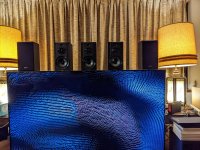
You can see I'm actually using 5 speakers here. The center channel plays full range down to 100Hz. The inside left and right play down to 600Hz. The outsides play 600Hz and down. This just helps to boost the stereo effect as the wavelengths start to get long compared to the width of the array. 3 speakers works great. 5 just gives it a little something extra and I happen to have lots of speakers and amp channels available.
Watch this video to see how the interference patterns produce excellent stereo throughout a huge range of frequencies. I used Falstadt's great ripple tank simulator to demonstrate how the effect works over a huge range of frequencies. http://www.falstad.com/ripple/Ripple.html. The three dots at the top of the screen represent an appropriately spaced array of 3 speakers playing a hard right panned signal. The circle down below represents the listener's head with strong signal reaching the right ear and weaker signal that is phase delayed reaching the left ear - as it should be. As I play a wide variety of frequencies you can see that strong stereo separation is maintained and no null from interference patterns ever crosses the right ear. You do get some weakening of the signal as the frequency goes down due to the center null widening so you can boost up the side channels in the lower frequencies or add a wider spaced set of speakers for the lower frequencies. I actually do both.
Login to view embedded media
So what happens with slightly panned signals? The same thing except the lobes are not as different, so no matter the panning there are no unwanted nulls from the interference patterns at the listener's ears.
Also notice what's happening off to the sides - not a lot of energy to light up early side wall reflections.
So how does it sound? I'm elated! It's great! It's not phase-y or weird. The sound stage is natural and oh so clear and smooth with beautiful separation and clarity. It's a revelation. On recordings with wild stereo effects they get really wild like they should. I don't see myself ever going back to a two speaker setup for high quality stereo playback. I tried having the outside speakers playing regular stereo from 600Hz down and it's just a downgrade. This is MUCH better IMHO even in lower frequencies where it looks like it's falling apart and just turning into mono. It's blowing my mind.
As a general starting guideline I recommend spacing the speakers at about 1 foot apart center to center for the 3 center speakers and put the listening position about 8 feet back. You'll hear some good stuff with just 3 speakers but you may need to put a low frequency boost on the side speakers to correct the tone for side panned sounds. You can do this by playing correlated pink noise and panning it left to right. Adjust the lower frequencies on the side speakers until the pink noise sounds similar in tone and volume across left, center, and right of the sound field. Experiment with spacing and listening distance. It's surprisingly flexible.
One difficulty is how to setup the matrix array. I use my Mac mini running Audio Hijack to do it in the digital domain. This allows matrix mixing and access to all 8 channels of my Denon receiver over HDMI. You can do a basic 3 speaker array using a 2 channel playback system by creating a L+R signal for the center speaker and a L-R signal for the side speakers. I run the L+R signal into the right channel, and the L-R into the left channel of the amp. The left channel runs both side speakers in series or parallel. Just wire up the right speaker opposite of the left speaker and it works!
I don't recommend mixing line level signals in the analog domain unless you have appropriate signal mixing hardware that that properly buffers everything. YMMV but my results were lackluster just using Y-connectors. I also don't recommend hooking multiple amp channels up to the same speaker unless you really know what you are doing. If you are using low pass and high pass crossovers on the outboard speakers like I am, watch out for phase reversals. Suddenly your soundstage is backwards!
12/30/2022 Update. After trying a lot of things I'm back to just 3 speakers. With proper spacing and the voids filled in between the speakers to minimize edge diffraction this really produces the purest sound and best imaging. I think I was tricked by the increased overall volume of adding more speakers. So there's something to that. If you have a lot of the same kind of speakers lying around and they can't play very loud, 7 of them playing at once makes a noticeably higher playback level possible than just 2 or 3 of them, and you can get some really great imaging. Turning up the volume a little to make up for the fewer speakers and I'm actually hearing better sound overall. This is great news because it's easier to set up as there are no time delays required and so a simple 2 channel amp and 2 channel dac can be used to power all 3 speakers. You just have to get the stereo signal matrixed into L+R and L-R signals. I heard one person say that the electric summing and differencing causes irretrievable loss of information. It does if you just take the L+R signal by itself, or the L-R signal by itself. But if you mix all the signals, including the inverted L-R, which gives R-L, everything that should reach the ears does. And, much less of what shouldn't.
Here's a picture of my current array using basic little Sony SSCS-5 speakers

You can see I'm actually using 5 speakers here. The center channel plays full range down to 100Hz. The inside left and right play down to 600Hz. The outsides play 600Hz and down. This just helps to boost the stereo effect as the wavelengths start to get long compared to the width of the array. 3 speakers works great. 5 just gives it a little something extra and I happen to have lots of speakers and amp channels available.
Watch this video to see how the interference patterns produce excellent stereo throughout a huge range of frequencies. I used Falstadt's great ripple tank simulator to demonstrate how the effect works over a huge range of frequencies. http://www.falstad.com/ripple/Ripple.html. The three dots at the top of the screen represent an appropriately spaced array of 3 speakers playing a hard right panned signal. The circle down below represents the listener's head with strong signal reaching the right ear and weaker signal that is phase delayed reaching the left ear - as it should be. As I play a wide variety of frequencies you can see that strong stereo separation is maintained and no null from interference patterns ever crosses the right ear. You do get some weakening of the signal as the frequency goes down due to the center null widening so you can boost up the side channels in the lower frequencies or add a wider spaced set of speakers for the lower frequencies. I actually do both.
Login to view embedded media
So what happens with slightly panned signals? The same thing except the lobes are not as different, so no matter the panning there are no unwanted nulls from the interference patterns at the listener's ears.
Also notice what's happening off to the sides - not a lot of energy to light up early side wall reflections.
So how does it sound? I'm elated! It's great! It's not phase-y or weird. The sound stage is natural and oh so clear and smooth with beautiful separation and clarity. It's a revelation. On recordings with wild stereo effects they get really wild like they should. I don't see myself ever going back to a two speaker setup for high quality stereo playback. I tried having the outside speakers playing regular stereo from 600Hz down and it's just a downgrade. This is MUCH better IMHO even in lower frequencies where it looks like it's falling apart and just turning into mono. It's blowing my mind.
As a general starting guideline I recommend spacing the speakers at about 1 foot apart center to center for the 3 center speakers and put the listening position about 8 feet back. You'll hear some good stuff with just 3 speakers but you may need to put a low frequency boost on the side speakers to correct the tone for side panned sounds. You can do this by playing correlated pink noise and panning it left to right. Adjust the lower frequencies on the side speakers until the pink noise sounds similar in tone and volume across left, center, and right of the sound field. Experiment with spacing and listening distance. It's surprisingly flexible.
One difficulty is how to setup the matrix array. I use my Mac mini running Audio Hijack to do it in the digital domain. This allows matrix mixing and access to all 8 channels of my Denon receiver over HDMI. You can do a basic 3 speaker array using a 2 channel playback system by creating a L+R signal for the center speaker and a L-R signal for the side speakers. I run the L+R signal into the right channel, and the L-R into the left channel of the amp. The left channel runs both side speakers in series or parallel. Just wire up the right speaker opposite of the left speaker and it works!
I don't recommend mixing line level signals in the analog domain unless you have appropriate signal mixing hardware that that properly buffers everything. YMMV but my results were lackluster just using Y-connectors. I also don't recommend hooking multiple amp channels up to the same speaker unless you really know what you are doing. If you are using low pass and high pass crossovers on the outboard speakers like I am, watch out for phase reversals. Suddenly your soundstage is backwards!
12/30/2022 Update. After trying a lot of things I'm back to just 3 speakers. With proper spacing and the voids filled in between the speakers to minimize edge diffraction this really produces the purest sound and best imaging. I think I was tricked by the increased overall volume of adding more speakers. So there's something to that. If you have a lot of the same kind of speakers lying around and they can't play very loud, 7 of them playing at once makes a noticeably higher playback level possible than just 2 or 3 of them, and you can get some really great imaging. Turning up the volume a little to make up for the fewer speakers and I'm actually hearing better sound overall. This is great news because it's easier to set up as there are no time delays required and so a simple 2 channel amp and 2 channel dac can be used to power all 3 speakers. You just have to get the stereo signal matrixed into L+R and L-R signals. I heard one person say that the electric summing and differencing causes irretrievable loss of information. It does if you just take the L+R signal by itself, or the L-R signal by itself. But if you mix all the signals, including the inverted L-R, which gives R-L, everything that should reach the ears does. And, much less of what shouldn't.
Sourcing a PCM1702U
Hello 🙂
I'm looking to obtain one or two PCM1702U chips ideally U-K, after researching I understand they are obsolete. I have looked at obtaining an Denon DCD to strip out the original BB 1702. However I subsequently confirmed they don't actually have 1702, a couple of web sites had suggested that they do 🙁 Looking at other devices that might have 1702 its clear they are only on top end kit and as such its not cheap to pick up a retro device only to strip out the DAC's...
I'm based in the UK, has anyone had any luck obtaining copied chips? and if so please let me know.. or does anyone have a couple that are known to work?
Clarification regarding quality/fake chips (clearly the chip obsolete, and my assumption is the fake chips are just a copy albeit not quality checked nor will they have been laser etched i.e internal parts that make up the internal circuit and that produce the high level of quality output
Regarding the fitment of the chip.. I need a U (SOP), there are J which are inserted into the boards. Is it possible to source a SOP to DIP for a 20pin U to J (as I understand the wiring is slightly different?!)
Silly Question... but if a DAC is only converting Digital bits into Volts for an OP Amp to process... can i not just bypass the DAC and insert an alternative board.. that can process Data and Clock signals? (its a silly question)

sorry for all the questions 🙂
I'm looking to obtain one or two PCM1702U chips ideally U-K, after researching I understand they are obsolete. I have looked at obtaining an Denon DCD to strip out the original BB 1702. However I subsequently confirmed they don't actually have 1702, a couple of web sites had suggested that they do 🙁 Looking at other devices that might have 1702 its clear they are only on top end kit and as such its not cheap to pick up a retro device only to strip out the DAC's...
I'm based in the UK, has anyone had any luck obtaining copied chips? and if so please let me know.. or does anyone have a couple that are known to work?
Clarification regarding quality/fake chips (clearly the chip obsolete, and my assumption is the fake chips are just a copy albeit not quality checked nor will they have been laser etched i.e internal parts that make up the internal circuit and that produce the high level of quality output
Regarding the fitment of the chip.. I need a U (SOP), there are J which are inserted into the boards. Is it possible to source a SOP to DIP for a 20pin U to J (as I understand the wiring is slightly different?!)
Silly Question... but if a DAC is only converting Digital bits into Volts for an OP Amp to process... can i not just bypass the DAC and insert an alternative board.. that can process Data and Clock signals? (its a silly question)
sorry for all the questions 🙂
FS: Nichicon LKG Super Through Capacitors, 4700uF 63V
I have 8 of these Nichicon Type III Super Through with gold plated terminals, for the highest audio quality.
Initially I had these in one of my amplifiers but decided I need higher voltage, so I need to buy 100V capacitors.
Basically these are like new, barely used
I am asking $10 each plus shipping.
Initially I had these in one of my amplifiers but decided I need higher voltage, so I need to buy 100V capacitors.
Basically these are like new, barely used
I am asking $10 each plus shipping.
Attachments
Amplifier design and stereo imaging
- By whoever
- The Lounge
- 187 Replies
in the process of doing listening tests, where the speakers are in the same position consistently, I notice differences in stereo imaging when changing out amplifiers, I was wondering, what are some of the contributing factors in the amplifier design that effect that?
Sansui G-2000 current gain sub tolerance
- By gto127
- Solid State
- 0 Replies
I was replacing the outputs in a sansui G2000 with what most recommend as subs KSA1010Y and KSC2334Y. Just wanted to know how critical is current gain matching in these. I am getting gain of 220 in KSA1010Y and 100 in KSC2334Y I ordered from digikey. I ordered several of each but all are that far apart. Anyone familiar with this receiver?
Recommended "audiophile" speaker design at $500-1000 in parts (excl. cabinets)?
Recommended "audiophile" speaker design at $500-1000 in parts (excl. cabinets)?
Hello, fellow audio enthusiasts! My strive for ever-better music reproduction led me to a point when I'm interested in the level of sound quality that I can't realistically afford at retail. So I'm looking for a DIY design and I would be very glad to hear any recommendations in the target price range ($500-1000 in parts, without the cabinets). And by a "design" I don't mean a full kit; just build plans + easily obtainable parts as of now.
I have a small room, 20 meters sq. (215 ft. sq.). I don't have a preference as for bookshelf vs. floor-standers. I like the look of floorstanders and have the space, but if the speaker's F3 is above 35 Hz then I don't see the point in making it floor-standing since it requires a subwoofer anyway. I can't pull the speakers away from the front wall far enough, 80 cm between the front baffle and the wall max. (OK, maybe 90 cm if it's worth it!). I suppose this makes any open baffle designs unviable?
Basically, I'm looking for the best sound quality, clarity, imaging/soundstage and listener engagement possible in the price range. Which designs would you recommend for my shortlist?
P. S. A simple cabinet design (no odd shapes and curves) is a plus, but not a strict requirement.
Hello, fellow audio enthusiasts! My strive for ever-better music reproduction led me to a point when I'm interested in the level of sound quality that I can't realistically afford at retail. So I'm looking for a DIY design and I would be very glad to hear any recommendations in the target price range ($500-1000 in parts, without the cabinets). And by a "design" I don't mean a full kit; just build plans + easily obtainable parts as of now.
I have a small room, 20 meters sq. (215 ft. sq.). I don't have a preference as for bookshelf vs. floor-standers. I like the look of floorstanders and have the space, but if the speaker's F3 is above 35 Hz then I don't see the point in making it floor-standing since it requires a subwoofer anyway. I can't pull the speakers away from the front wall far enough, 80 cm between the front baffle and the wall max. (OK, maybe 90 cm if it's worth it!). I suppose this makes any open baffle designs unviable?
Basically, I'm looking for the best sound quality, clarity, imaging/soundstage and listener engagement possible in the price range. Which designs would you recommend for my shortlist?
P. S. A simple cabinet design (no odd shapes and curves) is a plus, but not a strict requirement.
Amplifier load bank
- By malibutwins
- Equipment & Tools
- 5 Replies
I am building a load bank and wanted advice on wiring it. I have 4 4ohm 1000 watt resistors. I want to switch from 4 to 8 ohms. I am thinking of a nice rotary switch.
Discrepancies in inductance measurements of identical transformers
Hello there,
about a year ago I purchased a pair of mains transformers for my Aleph J amp. According to the production data they must be from the same batch. Today I accidentally discovered that they are different, I mean the inductances are different.
The inductances were measured with a DER EE DE-5000 LCR meter at 100Hz. The values are as follows:
Transformer 1:
Transformer 2:
Although it is difficult to measure an iron core inductor, the error should be identical for both transformers. Is it not? Moreover, the measured inductances does not match the voltage ratio of the transformer (L1/L2=(V1/V2)^2).
How shall I interpret the results? Is there anything to worry about? Shall I try different measurement methods?
Both transformers are specified for 230V input and 2x18V output. I connected them and measured the output voltages:
Transformer 1:
Transformer 2:
As far as I can tell, if the inductance were different, the output voltages would be different. I am definitely missing something here.
P.S. I noticed that the "transformer 1" is clearly noisier. You can tell that it has more hum.
about a year ago I purchased a pair of mains transformers for my Aleph J amp. According to the production data they must be from the same batch. Today I accidentally discovered that they are different, I mean the inductances are different.
The inductances were measured with a DER EE DE-5000 LCR meter at 100Hz. The values are as follows:
Transformer 1:
230V input - 6500mH
18V out 1 - 121mH
18V out 2 - 119mH
Transformer 2:
230V input - 8900mH
18V out 1 - 190mH
18V out 2 - 188mH
Although it is difficult to measure an iron core inductor, the error should be identical for both transformers. Is it not? Moreover, the measured inductances does not match the voltage ratio of the transformer (L1/L2=(V1/V2)^2).
How shall I interpret the results? Is there anything to worry about? Shall I try different measurement methods?
Both transformers are specified for 230V input and 2x18V output. I connected them and measured the output voltages:
Transformer 1:
230V input - 228.7V
18V out 1 - 18.8V
18V out 2 - 18.9V
Transformer 2:
230V input - 229.3V
18V out 1 - 18.8V
18V out 2 - 18.9V
As far as I can tell, if the inductance were different, the output voltages would be different. I am definitely missing something here.
P.S. I noticed that the "transformer 1" is clearly noisier. You can tell that it has more hum.
Attachments
Replace Mospec BD907 in amp
Hi,
I received an amp and 2 days after, my amp blown. The problem was that my MOSPEC BD907 was broken. So I asked my local store a replacement part, and they gave me a MJE3055t. I replace the part and my amp is still on safe mode.
I asked someone to repare it and after verification, he said that I absolutly need the same MOSPEC BD907 or my amp will always stays on sade mode.
I can't find the same part at good price on the Internet.
Someone at digikey says that this part : onsemi 2N6487G will do the job to replace my Mospec Bd907.
Can someone help me with that? I don't want to spend too much for this amp and if someone can tell me what to with that it would be appreciated.
Thank you! (Sorry for my english i'm french)
I received an amp and 2 days after, my amp blown. The problem was that my MOSPEC BD907 was broken. So I asked my local store a replacement part, and they gave me a MJE3055t. I replace the part and my amp is still on safe mode.
I asked someone to repare it and after verification, he said that I absolutly need the same MOSPEC BD907 or my amp will always stays on sade mode.
I can't find the same part at good price on the Internet.
Someone at digikey says that this part : onsemi 2N6487G will do the job to replace my Mospec Bd907.
Can someone help me with that? I don't want to spend too much for this amp and if someone can tell me what to with that it would be appreciated.
Thank you! (Sorry for my english i'm french)
Attachments
DC Voltage on Amp output and hiss
- By Cglaks2019
- Solid State
- 11 Replies
Hello, a friend gifted me a harman/kardon AVR255 7.1 amplifier. Front left speaker output is outputting DC Voltage between 1.73-1.93 V depending on the volume level. On the front right speaker could not detect dc volt output(0.03V).
Is that 1.73-1.93V DC normal? Why is it happening? Is there any chance that it could damage my speakers?
There is also a hiss on the front left speaker that you can hear if you go close to the loudspeaker. The hiss level remains the same regardless of the volume knob position
Is that 1.73-1.93V DC normal? Why is it happening? Is there any chance that it could damage my speakers?
There is also a hiss on the front left speaker that you can hear if you go close to the loudspeaker. The hiss level remains the same regardless of the volume knob position
Semi-DIY Phono Preamp
- Electronic Design
- 3 Replies
Hello! For a couple of days now I have an urge to build myself a MM phono pre, based on (ripped off from) Pioneer's SA-9800 phono stage with some added bells and whistles like Signal Transfer's Devinyliser and Pass Labs' H2 for a sort of "tube mode" switch. Problem is, I'm sort of a dummy when it comes to electronics, I can solder, I've successfully serviced some turntables and cassette decks, but when it comes to schematics and PCB design i'm out (It will be my first time attempting something like this). I thought I'll just chuck a scan of the SM's PCB pattern into KiCAD and trace the whole board out, but do I need the whole board? Schematics show some rotary selector, but I don't need such things as I planned to make only one input and that's the MM only one (Phono 1). Could someone put me on the right path there and maybe help with determining what (if anything) could be removed from the board? Thanks in advance. P.S. Any pics of the board itself would be appreciated as well
Attachments
What is this type of ubiquitous switch called?
- By rockstudio
- Parts
- 5 Replies
I feel like a noob asking this, but for some reason I've never been able to even come across this type of switch while building gear for the last 19 years. Thanks🙂
Attachments
Desktop remote interface for Exogal Comet Plus DAC
- By MichRT
- Digital Line Level
- 10 Replies
Hi!
After trying a handful of DACs, I found love with the Exogal Comet Plus. However, it's user interface.... barely exists. It has a small silver LCD screen that can be a bit difficult to read and is primarily controlled via a BT remote or a depreciated app (Android 9 or lower only). Either remote option can be unreliable at times, so I set out to create a better solution.
My idea was to use an Arduino to directly send the remote commands, removing the need for wireless shenanigans, or to use a Raspberry Pi to operate the DAC from a web portal. I probed the DAC Bluetooth chip output but hit a dead end. Thanks to Bob (from Exogal) backing up some dealer info, there is enough documentation to use the TTL serial port on the back for firmware updates. Huge help and starting point. I reached out to Jeff (also from Exogal) who was immensely helpful as well, and helped me get the ball rolling.
Turns out you can control the DAC via the serial port! Using a USB-to-serial adapter cable, I wrote an app that interfaces with Comet! Written in Python since it’s what I’m familiar with. It’s a simple button-based GUI app that currently allows you to select which COM port to use, power on/off, select input and output, mute/half-mute/unmute, increase/decrease volume, or enter a specific volume value. All through the desktop app!

But I want hardware. Ran out of pro micros so I grabbed a few $5 Raspberry Pi Pico micro controller boards to try. MircoPython is great!
Login to view embedded media Login to view embedded media Login to view embedded media So far I've got most of the code sorted between a rotary encoder and a display. More work to be done but progress feels good. I plan to use 2x of those displays since I have a few already: 1x for big font Input/Output/Power, the other for Volume/Mute. Next up is to add an IR receiver to handle desktop volume adjustment and living room IR remote use.
Huge thanks to Jeff, Bob, and others for helping keep this DAC alive and well. Not sure how many people care about this, but I'd like to share it with those that do. Been waiting on solutions like this for a long while - long enough to try to do it myself. Thanks!
I want to applaud "Future Audiophile"'s coverage in two product catagories
- The Lounge
- 0 Replies
I have a friend who is looking to (retire), and to downsize and rationalize his audio system.
I say rationalize, because it's a lot easier to call up music from a streaming service like Qobuz, than to find a CD. On the other hand, he also has an LP collection that dates back to circa 1972, and he wants to be able to play an LP every now and then.
So, he asked my advice. Because I usually review components that are components, and not complete systems in one box, I went looking for benchmark reviews.
I found "Future Audiophile"'s coverage of Digital Streamers to be well organized, and very informative.
The other category I found to be very informative was their coverage of Amplifiers, mostly because "Future Audiophile" champions GaN (Gallium Nitride) amplifiers, and modular switching amplifiers based on Hypex or Purifi amp modules.
That said, the one unit that caught my eye, and I would appreciate any user comments on it, is NAD's Retro integrated amp, which has an optional card for BluOs and... Dirac Room Correction.
I'll have to look into whether it is set up for Qobuz, but right now it looks like a potential optimal choice.
Any helpful comments (or recommendations for competing products) will be very appreciated!
john
Phono pre to tape head pre-help with equalization
- By robnec
- Analogue Source
- 8 Replies
Hello. I have a phono pre built many years ago. It was an expensive project and worked very well. Problem is I do not use it since I switched to strain gauge system. It is the shame to keep it idle on the shelf.
I was thinking to redo it as a tape head pre for NAB decks. I saw many threads about doing it. Could someone take a look and direct me how to change an equalization from RIAA to NAB? I can follow a scematic but not much more.🙂
Thanks for help. Robert.
I was thinking to redo it as a tape head pre for NAB decks. I saw many threads about doing it. Could someone take a look and direct me how to change an equalization from RIAA to NAB? I can follow a scematic but not much more.🙂
Thanks for help. Robert.
Attachments
help Yorkville AP4040 keep burning 4.7 volt zener diode on both channel
- By drking1
- Solid State
- 11 Replies
good day my friends i am repairing a ap4040 yorkville amp that keep blowing a zener on both channels i have check every transistor and resistor everything how they are supposed read please help as i can't find cause
Anyone upgraded Focal Aria crossovers?
- By adrianjones
- Multi-Way
- 182 Replies
Hi,
I've messed about with crossovers on several speakers and built some really good speakers in the past. Has anyone had a look at upgrade components for their Focal Aria speakers? I have the 906.
I've messed about with crossovers on several speakers and built some really good speakers in the past. Has anyone had a look at upgrade components for their Focal Aria speakers? I have the 906.
For Sale Pearl 2 Preamp from Pass DIY, Complete
I'm letting go of my Pearl 2 phono preamp that has served me well for the past 6 years, built with matched Vishay Dale RN65 resistors. The boards were positioned so as to provide the shortest path to the RCA input connectors.
The preamp and its power supply are housed in Modushop Galaxy chassis with 10mm front panels and connected with a 6' power supply cable and Neutrik Powercon connectors.
The power supply utilizes an AnTek AS-0522 50VA transformer and EPCOS caps.
$300 + shipping, or pickup at an agreed location in the SF Bay area.
Current prices:
Boards and JFETS from Pass DIY, $200
Galaxy chassis, just over $100 + ~$30 shipping for the pair
AS-0522, $20 + shipping
Powercons, ~$16




The preamp and its power supply are housed in Modushop Galaxy chassis with 10mm front panels and connected with a 6' power supply cable and Neutrik Powercon connectors.
The power supply utilizes an AnTek AS-0522 50VA transformer and EPCOS caps.
$300 + shipping, or pickup at an agreed location in the SF Bay area.
Current prices:
Boards and JFETS from Pass DIY, $200
Galaxy chassis, just over $100 + ~$30 shipping for the pair
AS-0522, $20 + shipping
Powercons, ~$16
a blind test that pushed me to study speakers more
- By ginetto61
- The Lounge
- 71 Replies
Hi to Everyone
The test is the following in Spanish
https://www.matrixhifi.com/contenedor_ppec.htm
can this test be dependable ?
after reading this my main interest has moved to speakers technology
also because i have one a500 already 😉
The test is the following in Spanish
https://www.matrixhifi.com/contenedor_ppec.htm
can this test be dependable ?
after reading this my main interest has moved to speakers technology
also because i have one a500 already 😉
Of course it will work, it's guaranteed!
- By Tubelab_com
- Tubes / Valves
- 37 Replies
I have been working on a gain stage / driver circuit that is capable of delivering 100 volts peak-to-peak or more at a very low distortion level. The circuit is such that it will work with dozens of different tube types with minimal changes, just two resistor values. The test board has a 7 pin socket and a 9 pin socket wired in parallel so that I can try lots of different tubes. I have been going through my tube collection trying anything that will electrically fit either socket and taking data on what works and what does not. I had over 100,000 tubes thirty some years ago, but many have been sold, traded, given away or trashed over the years. There are still thousands of tubes in bags, and some boxed tubes in trays. I have a list of over 60 type numbers that will work in my test board, and I recently started testing some of the tubes in the board. I am now on my third 7 pin socket having run several hundred tubes through the first two.
Yesterday I came across a pair of boxed tubes with a rather strange label on the box. This is brand recognition at its best....NOT! I introduce the new "GUARANTEED ELECTRON TUBE." It appears to be guaranteed to be a "Used" or "Factory Second" tube. Not necessarily a good tube. Both are "TRU-Vac" brand, and even that is not "TRU." The 6CB6 on the left does work and produces some good THD numbers, sometimes. It is highly microphonic and will exhibit a G1 to G2 short whenever it wants to. A whack with a pencil triggers the short or clears it. The little 6AK5 lights up purple, gets real hot and outputs no signal, or random noise. Its vacuum is not very TRU as its getter is nearly gone. If I find any more of these boxes, the tubes will be "tested" before disposal!
Many tube rollers believe that tubes with yellow ink on them are better than others with the same type numbers. Previous testing with WE 417A's up against Raytheon 5842's show that this may have some merit as the WE's consistently beat the Raytheon's in THD testing, but they are slightly different tubes, despite some WE's wearing both type numbers. I have found 5 WE 6AK5's in a random handful of about 50 assorted used 6AK5's which were pulled from a much bigger bag. Note that the tube on the right has very little getter left. It has likely seen a lot of use. How well does it work? How about 0.148% THD at 35.7 Vrms (100 V p-p). The other four WE tubes all showed THD's under 0.2%. I have run a few hundred used 7 pin tubes through this board to test them. The scope screen shows two traces, the input and output signal after the level knob on the output trace was adjusted to overlay the two traces with a new tube. I tossed any tube that did not produce a THD level under 0.4% or when the two scope traces showed an abnormal gain or significant trace deviation when whacked with a pencil.
The circuit also works with the usual 9 pin TV IF amp tubes like the 6EJ7 / EF184. It is seen here with a 6KT6 in the hot seat making 0.169% THD. I have a lot more tubes to test.
During the development of this circuit, I saw a low of 0.0699% THD on one little 7 pin tube. When cranked to 50 Vrms (141 Vp-p) the THD went to 0.514%. The residual THD of my old HP204D oscillator is 0.04% at 1KHz. It is the better of two identical oscillators.
Before anybody asks, yes, I have stuffed two tubes into the board at the same time. Nothing bad happens, but the result is not worth photographing, just some so-so numbers with no smoke. So far, the only unexpected effects were some verbal outbursts from accidentally touching the tab on the mosfet while hot swapping tubes.
Yesterday I came across a pair of boxed tubes with a rather strange label on the box. This is brand recognition at its best....NOT! I introduce the new "GUARANTEED ELECTRON TUBE." It appears to be guaranteed to be a "Used" or "Factory Second" tube. Not necessarily a good tube. Both are "TRU-Vac" brand, and even that is not "TRU." The 6CB6 on the left does work and produces some good THD numbers, sometimes. It is highly microphonic and will exhibit a G1 to G2 short whenever it wants to. A whack with a pencil triggers the short or clears it. The little 6AK5 lights up purple, gets real hot and outputs no signal, or random noise. Its vacuum is not very TRU as its getter is nearly gone. If I find any more of these boxes, the tubes will be "tested" before disposal!
Many tube rollers believe that tubes with yellow ink on them are better than others with the same type numbers. Previous testing with WE 417A's up against Raytheon 5842's show that this may have some merit as the WE's consistently beat the Raytheon's in THD testing, but they are slightly different tubes, despite some WE's wearing both type numbers. I have found 5 WE 6AK5's in a random handful of about 50 assorted used 6AK5's which were pulled from a much bigger bag. Note that the tube on the right has very little getter left. It has likely seen a lot of use. How well does it work? How about 0.148% THD at 35.7 Vrms (100 V p-p). The other four WE tubes all showed THD's under 0.2%. I have run a few hundred used 7 pin tubes through this board to test them. The scope screen shows two traces, the input and output signal after the level knob on the output trace was adjusted to overlay the two traces with a new tube. I tossed any tube that did not produce a THD level under 0.4% or when the two scope traces showed an abnormal gain or significant trace deviation when whacked with a pencil.
The circuit also works with the usual 9 pin TV IF amp tubes like the 6EJ7 / EF184. It is seen here with a 6KT6 in the hot seat making 0.169% THD. I have a lot more tubes to test.
During the development of this circuit, I saw a low of 0.0699% THD on one little 7 pin tube. When cranked to 50 Vrms (141 Vp-p) the THD went to 0.514%. The residual THD of my old HP204D oscillator is 0.04% at 1KHz. It is the better of two identical oscillators.
Before anybody asks, yes, I have stuffed two tubes into the board at the same time. Nothing bad happens, but the result is not worth photographing, just some so-so numbers with no smoke. So far, the only unexpected effects were some verbal outbursts from accidentally touching the tab on the mosfet while hot swapping tubes.
Attachments
-
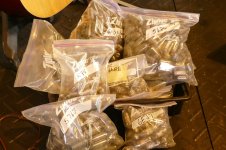 P4070523.JPG417.2 KB · Views: 284
P4070523.JPG417.2 KB · Views: 284 -
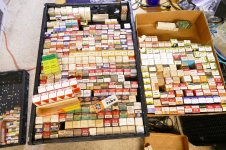 P4070528.JPG648.6 KB · Views: 239
P4070528.JPG648.6 KB · Views: 239 -
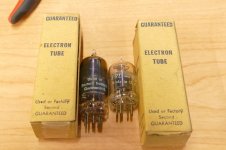 P4070520.JPG297.8 KB · Views: 237
P4070520.JPG297.8 KB · Views: 237 -
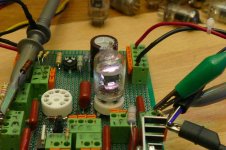 P4070484.JPG441.2 KB · Views: 237
P4070484.JPG441.2 KB · Views: 237 -
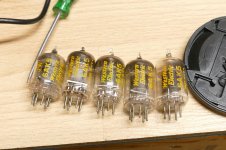 P4070447.JPG402.8 KB · Views: 240
P4070447.JPG402.8 KB · Views: 240 -
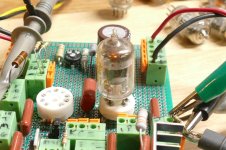 P4070442.JPG407.9 KB · Views: 229
P4070442.JPG407.9 KB · Views: 229 -
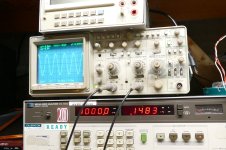 P4070444.JPG398.5 KB · Views: 231
P4070444.JPG398.5 KB · Views: 231 -
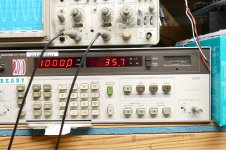 P4070445.JPG454.1 KB · Views: 235
P4070445.JPG454.1 KB · Views: 235 -
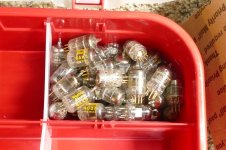 P4070510.JPG408.8 KB · Views: 223
P4070510.JPG408.8 KB · Views: 223 -
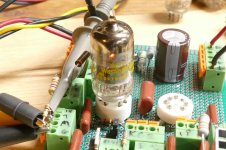 P4070427.JPG387.5 KB · Views: 234
P4070427.JPG387.5 KB · Views: 234 -
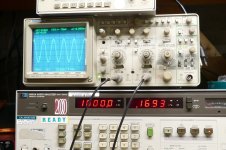 P4070428.JPG407.9 KB · Views: 223
P4070428.JPG407.9 KB · Views: 223 -
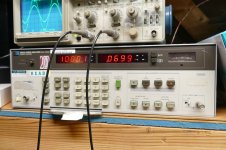 P4020471.JPG338.1 KB · Views: 209
P4020471.JPG338.1 KB · Views: 209 -
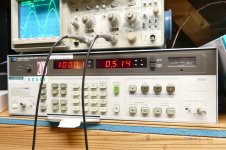 P4020473.JPG355.9 KB · Views: 205
P4020473.JPG355.9 KB · Views: 205 -
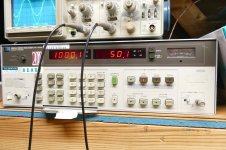 P4020472.JPG416.3 KB · Views: 221
P4020472.JPG416.3 KB · Views: 221 -
 P4020535.JPG403.8 KB · Views: 247
P4020535.JPG403.8 KB · Views: 247
Hello from Germany!
- By ma__wu
- Introductions
- 6 Replies
Good morning!
I am Maik from southern Germany and working as a development engineer.
I'm familiar with common electronics, but absolutely new to audio applications.
I'm working on a small phone project and hope to learn how to set up the PCB audio circuits for my microcontroller 🙂
I am Maik from southern Germany and working as a development engineer.
I'm familiar with common electronics, but absolutely new to audio applications.
I'm working on a small phone project and hope to learn how to set up the PCB audio circuits for my microcontroller 🙂
Output coupling capacitor size
- By ma__wu
- Electronic Design
- 8 Replies
Hi all,
for my phone project i am now designing the audio circuits.
I have a SIM module with a mono output and amplify it with a PAM8302A amplifier to a 8 Ohm speaker.
Now, there are tons of tutorials/post about chosing the right capacitor in terms of capacitance value.
My questions is: What about the power rating? I want my PCB to be as small as possible, and i'm afraid a too small SMD capacitor will pop on my PCB. After all, the whole power for this 1,5W speaker gets transferred through the capacitors. I haven't found a good answer yet.
Can you help with that?
(For reference, i will be using a 220 Ohm resistor in series with the 8 ohm speaker and a 47uF output coupling capacitor, to bring my cutoff frequency down to around 15Hz. I tried it and it sounds great).
Thanks and have a good day!
-Maik
for my phone project i am now designing the audio circuits.
I have a SIM module with a mono output and amplify it with a PAM8302A amplifier to a 8 Ohm speaker.
Now, there are tons of tutorials/post about chosing the right capacitor in terms of capacitance value.
My questions is: What about the power rating? I want my PCB to be as small as possible, and i'm afraid a too small SMD capacitor will pop on my PCB. After all, the whole power for this 1,5W speaker gets transferred through the capacitors. I haven't found a good answer yet.
Can you help with that?
(For reference, i will be using a 220 Ohm resistor in series with the 8 ohm speaker and a 47uF output coupling capacitor, to bring my cutoff frequency down to around 15Hz. I tried it and it sounds great).
Thanks and have a good day!
-Maik
B&C DCX 215
Hi All -
This design finally went live:
https://www.bcspeakers.com/media/W1siZiIsIjIwMjEvMDgvMDMvMTBfMTRfMDJfNTU4XzIxNURDWC5wZGYiXV0
I wonder how it would compare to the Danley Signature Series or even the SH50s.
Cheers,
Ian
This design finally went live:
https://www.bcspeakers.com/media/W1siZiIsIjIwMjEvMDgvMDMvMTBfMTRfMDJfNTU4XzIxNURDWC5wZGYiXV0
I wonder how it would compare to the Danley Signature Series or even the SH50s.
Cheers,
Ian
Triode - pentode switch conversion for Citation II amp
- By Lmitchell
- Tubes / Valves
- 7 Replies
I need a schematic of how to convert a Harmon Kardon Citation II amp from triode top pentode mode.
Right now I have a 270 ohm resistor going from pin 4 of a Kt88 tube to 2nd & 4th connections on output transformer.
What do i need to change?
Right now I have a 270 ohm resistor going from pin 4 of a Kt88 tube to 2nd & 4th connections on output transformer.
What do i need to change?
Mystery Philips ECC81 tube code
- By mdr30
- Tubes / Valves
- 2 Replies
Any Danes around? Bought a batch of tubes and this one had all prints scrubbed off. However, there was a code on the underside of the tube which revealed it was an ECC81 made by Philips in Copenhagen, Denmark. Horse-shoe getter and ribbed short plates. Strangely enough no date codes (may have been printed on the glass), only a "+" sign after the Copenhagen pyramid symbol. Can anyone shed a light on this?


What do you call the design that has mid woofer inside cabinet firing upward?
Hello,
I have vintage compact floorstanding speakers (JMR-Jean Marie Reynaud) which has a mid woofer installed inside speaker cabinet firing upward, and tweeter and another mid woofer facing forward. Is there specific terminology for this kind of speaker configuration? Not sure if it is called Isobaric configuration or another terminology for it.
If anyone educate me on this would be hugely appreciated.
Thank you very much.
I have vintage compact floorstanding speakers (JMR-Jean Marie Reynaud) which has a mid woofer installed inside speaker cabinet firing upward, and tweeter and another mid woofer facing forward. Is there specific terminology for this kind of speaker configuration? Not sure if it is called Isobaric configuration or another terminology for it.
If anyone educate me on this would be hugely appreciated.
Thank you very much.
Free: SOtM tX-USBexp card
- By bourbon-neat
- Swap Meet
- 4 Replies
I have a SOtM tX-USBexp card that I'm not using and want to give away. This card is a USB interface that you can add to a PC. I've used them with Windows and Linux.
Info: https://www.sotm-audio.com/sotmwp/english/portfolio-item/tx-usbexp/
Manual: https://www.sotm-audio.com/files/Accessories/tX-USBexp/tX-USBexp_Operating_Instructions_Rev1.7a.pdf
Local pick up in San Jose, CA or USPS flat rate $20 for continental USA.
Info: https://www.sotm-audio.com/sotmwp/english/portfolio-item/tx-usbexp/
Manual: https://www.sotm-audio.com/files/Accessories/tX-USBexp/tX-USBexp_Operating_Instructions_Rev1.7a.pdf
Local pick up in San Jose, CA or USPS flat rate $20 for continental USA.
Attachments
Cheap but very good sounding opAmp recommendation for Fosi Audio ZA3
Hi, I'm looking for advice on a cheaper opamp for the fosi audio za3 that sounds as good as the burson audio v7 live, sparcos lab s 3602 opamps
It is impossible to buy Burson audio v7 live, sparkos labs ss3602 in Turkey and products coming from outside Turkey are subject to 60% tax and products worth more than 30 € are detained at customs, so I am looking for a cheaper opamp with good sound and I am waiting for your advice on this issue.
It is impossible to buy Burson audio v7 live, sparkos labs ss3602 in Turkey and products coming from outside Turkey are subject to 60% tax and products worth more than 30 € are detained at customs, so I am looking for a cheaper opamp with good sound and I am waiting for your advice on this issue.
For Sale ICEpower 125ASX2 based amp complete
For Sale: ICEPower 125ASX2 amp module in a Carvin DCM200L 1U chassis.
Bandmates blew up original Carvin amp years ago, so I just replaced the Carvin "guts" with an Icepower 125ASX2 stereo module I had. I connected the aux power from module to the amp to drive the preamp / gain control and power / clipping LEDs in front panel.
Both XLR and 1/4" inputs work as inputs. Parallel switch in back will mono channel 1 input to both channels. There is an "EQ Expand" button in front that seems to change sound that also works...
How's $250 shipped conus?
Bandmates blew up original Carvin amp years ago, so I just replaced the Carvin "guts" with an Icepower 125ASX2 stereo module I had. I connected the aux power from module to the amp to drive the preamp / gain control and power / clipping LEDs in front panel.
Both XLR and 1/4" inputs work as inputs. Parallel switch in back will mono channel 1 input to both channels. There is an "EQ Expand" button in front that seems to change sound that also works...
How's $250 shipped conus?
Attachments
Understanding dipole "equivalent" layouts + possible pros/cons
I'm curious:
I've been reading a ton about open baffle designs, ranging from huge baffles to fully "nude" systems, and in all combinations of dipole + monopole combinations across the frequency spectrum.
Since most tweeters are monopole, many designers add tweeters on the back of the baffle/system. I've even seen this on closed box systems. It made me wonder in which ways that kind of solution might be better, different, or worse than dipole tweeters?
Could this extend to the midrange, say, with 2 mids mounted back to back in a tube the diameter of the drivers, wired out of phase?
What would happen as the wavelengths get longer... maybe identical sealed (or ported) chambers front and back, with the drivers again wired out of phase?
I'm curious whether any advantages (or disadvantages) could ensue:
- How many ways are there to generate dipole patterns?
- Do any of the alternate approaches have particular advantages and disadvantages to learn from?
I've been reading a ton about open baffle designs, ranging from huge baffles to fully "nude" systems, and in all combinations of dipole + monopole combinations across the frequency spectrum.
Since most tweeters are monopole, many designers add tweeters on the back of the baffle/system. I've even seen this on closed box systems. It made me wonder in which ways that kind of solution might be better, different, or worse than dipole tweeters?
Could this extend to the midrange, say, with 2 mids mounted back to back in a tube the diameter of the drivers, wired out of phase?
What would happen as the wavelengths get longer... maybe identical sealed (or ported) chambers front and back, with the drivers again wired out of phase?
I'm curious whether any advantages (or disadvantages) could ensue:
- Dipole sound, "closed box" aesthetic?
- Instantly change your speaker from being dipole to monopole depending on the music or mood or room placement (e.g. shoved to wall or not) using DSP?
- Other thoughts?
Request for help from Dutch member
- By Studley
- Everything Else
- 2 Replies
There is an item located in the Netherlands that is for sale on Marktplaats. I cannot register and message the seller because I only have a UK telephone number. Would some kind person be willing to put me in touch with the seller?
For Sale Sbooster BOTW P&P ECO 5-6V Lineair PSU
- By Geluidloopt
- Swap Meet
- 0 Replies
Selling an SBooster BOTW 5-6V Lineair PSU
5/6V (3A)
Asking 135€, will ship worldwide
5/6V (3A)
Asking 135€, will ship worldwide
Attachments
7.1 channel(4AES/EBU) to HDMI output converter
- By yulen
- Vendor's Bazaar
- 1 Replies
Login to view embedded media
Video equipment connection:
PC -> USB TO 4AES -> 4AES TO HDMI -> HDMI TO 4AES -> AES TO active monitor speakers
4AES is 4-channel AES/EBU digital audio signal, that is, 8-channel audio signal
1. USB TO 4AES: $120
2. HDMI TO 4AES: $190, DSP expansion card: $30
3. 4AES TO HDMI: $258.
USB TO 4AES
1. Supports WIN, Apple, and Android systems, plug and play. There are two models, one is an external USB interface box, and the other is a full-height computer baffle.
HDMI TO 4AES
1. Two HDMI inputs, one HDMI output, and the output supports up to 4K@30Hz.
2. 4 groups of AES/EBU outputs. The audio format required for HDMI transmission is LPCM, with a maximum of 8 channels
3. The DSP function can be expanded. The DSP expansion card is realized through the 4 groups of I2S interfaces on the motherboard. To use the DSP function, you need to use the sigma studio tool and have the USBi tool.
4. With remote control, multiple functions can be realized
4AES TO HDMI
1. 4 groups of AES/EBU input (can be changed to 8-channel analog input through appropriate modification), 1 HDMI output.
2. 4AES/EBU input can be input through DB25 or RJ45 interface.
3. Each group of AES/EBU input has ASRC sampling conversion function. The audio in HDMI is output at a fixed 48KH sampling rate.
4. Volume adjustment and other algorithms can be realized through the expanded DSP function.
Video equipment connection:
PC -> USB TO 4AES -> 4AES TO HDMI -> HDMI TO 4AES -> AES TO active monitor speakers
4AES is 4-channel AES/EBU digital audio signal, that is, 8-channel audio signal
1. USB TO 4AES: $120
2. HDMI TO 4AES: $190, DSP expansion card: $30
3. 4AES TO HDMI: $258.
USB TO 4AES
1. Supports WIN, Apple, and Android systems, plug and play. There are two models, one is an external USB interface box, and the other is a full-height computer baffle.
HDMI TO 4AES
1. Two HDMI inputs, one HDMI output, and the output supports up to 4K@30Hz.
2. 4 groups of AES/EBU outputs. The audio format required for HDMI transmission is LPCM, with a maximum of 8 channels
3. The DSP function can be expanded. The DSP expansion card is realized through the 4 groups of I2S interfaces on the motherboard. To use the DSP function, you need to use the sigma studio tool and have the USBi tool.
4. With remote control, multiple functions can be realized
If the DSP function is expanded, the remote control function can be customized
Dolby CP750/CP650 control expansion, etc.
4AES TO HDMI
1. 4 groups of AES/EBU input (can be changed to 8-channel analog input through appropriate modification), 1 HDMI output.
2. 4AES/EBU input can be input through DB25 or RJ45 interface.
3. Each group of AES/EBU input has ASRC sampling conversion function. The audio in HDMI is output at a fixed 48KH sampling rate.
4. Volume adjustment and other algorithms can be realized through the expanded DSP function.
Tube buffered LM3886
Hello everyone,
I decided to make a tube buffered IC amp, although tubers or gaincloners won't like it.
And I liked tubecad's tube buffered (with CCS) chipamp design. However, I have 12AU7, 5751 and a few 12AX7. To be honest, I didn't want to buy a 6DJ8 just for this project.
However, the CCS on the cathode of the tube is 10ma and this would be a high bias for the tubes I have. So I decided to use 2x parallel 12au7. This would give me a quiet bias of 5ma per cathode.
I decided to use LM317L, which I have used before and was happy with, set to 10ma, as the CCS.
And this is the circuit that came out..
What I want to ask is, this circuit gives THD values like 0.05% in the simulation.. Also, according to the FFT results, the weighted harmonic is 2. (A harmonic that I personally like) Do you think something like this is possible? Or is this circuit worth making?
Thanks in advance..
PS: 317's resistor should be 120 not 150...
I decided to make a tube buffered IC amp, although tubers or gaincloners won't like it.
And I liked tubecad's tube buffered (with CCS) chipamp design. However, I have 12AU7, 5751 and a few 12AX7. To be honest, I didn't want to buy a 6DJ8 just for this project.
However, the CCS on the cathode of the tube is 10ma and this would be a high bias for the tubes I have. So I decided to use 2x parallel 12au7. This would give me a quiet bias of 5ma per cathode.
I decided to use LM317L, which I have used before and was happy with, set to 10ma, as the CCS.
And this is the circuit that came out..
What I want to ask is, this circuit gives THD values like 0.05% in the simulation.. Also, according to the FFT results, the weighted harmonic is 2. (A harmonic that I personally like) Do you think something like this is possible? Or is this circuit worth making?
Thanks in advance..
PS: 317's resistor should be 120 not 150...
Attachments
Chassis design service
- By Halauhula
- Software Tools
- 11 Replies
Anyone is the US willing to design, for a fee, DXF files for me to submit to Modushop for panels? I did some searches in various fora, but did not get anything.
I would provide scans of hand-generated design on graph paper, with appropriate dimensional information. Punching is only what I would news, no graphics or labels to be engraved.
I would provide scans of hand-generated design on graph paper, with appropriate dimensional information. Punching is only what I would news, no graphics or labels to be engraved.
Double Diamond Amplifier with Current Feedback
- By lineup
- Solid State
- 34 Replies
Has 2 diamonds.
One for the input and one for the output.
Current Feedback goes back to the input part.
R20 must be 2 Watt.
THD 0.00018% (-114.9dB)

One for the input and one for the output.
Current Feedback goes back to the input part.
R20 must be 2 Watt.
THD 0.00018% (-114.9dB)
Carver AV-405 power supply board protection circuit question
- By carlos515
- Power Supplies
- 2 Replies
I would like to reuse my Carver power supply board for DIY amp boards. The board has 2 bridge rectifiers that supply different voltages. This would be useful for my project. There were thermal switches on the old amp boards. Can I use the board without them? Also, would this affect my speaker delay protection circuit on board ?
Attachments
TVS Diode
I am trying to identify the part in the photo below market TX8FGS7, I believe its a TVS diode. I have looked online but can't find a data sheet or equivalent could anyone offer and advice on a UK supplier, data sheet or equivalent.
David..
David..
Attachments
please criticize my design for a very large multi-way system
- By axiperiodic
- Multi-Way
- 118 Replies
all right i'm attaching some sketches to help you visualize what i have in mind ...
this design has gone through a bunch of iterations and some aspects of it keep sort of vacillating which i will address later ...
for now i will just describe what the current iteration is, as depicted in the sketches ...
5-way system consisting of a center subwoofer stack that goes between the two main 4-way speakers ...
both speakers and subwoofer stack are 80" tall ( to fit in basements ) and the width is 32" for speakers because that's 1/3 of 96" that plywood comes in ... and 2 x 32" for the subwoofer stack. each subwoofer module is 25.5 x 32 x 40 inches, with a total of four modules. 25.5" is just 24" + 2 thicknesses of plywood. the main speakers would have approximately similar depth ( about 2 feet ) but since they curve towards the listener they don't have any hard number for their depth ...
in my sketches you can also see a 75" TV mounted on the subwoofer stack ... that is indeed where the TV will go but it doesn't have to be 75" ... although the width of 75" matches the width of the subwoofer stack exactly, which may or may not be a coincidence ...
total system width would be about 12 feet which is about as narrow as i could get it but it should allow it to fit in most living rooms outside of NYC and SF.
in the current iteration of the design the driver compliment is as follows
25 hz - 80 hz:
https://www.eighteensound.it/en/products/lf-driver/21-0/4/21ntlw5000-4350 liter net box, vented, tuned to 25 hz ...
four such boxes in the center behind the screen ...
80 hz - 200 hz:
https://www.parts-express.com/JBL-2262HPL-338312-004X-12-Neo-Woofer-294-45040 liter net box, vented, tuned to 70 hz
four 8 ohm drivers per side for a total 2 ohm load
200 hz - 800 hz:
https://www.eighteensound.it/en/products/lf-driver/8-0/8/8NTLW20005 liter net box, vented, tuned to 130 hz
four 8 ohm drivers per side for a total of 2 ohm load
800 hz - 3 khz:
https://www.bmsspeakers.com/index.php-62.html?id=bms_4594nd-midon the following horn:
https://www.bcspeakers.com/en/products/horn/1-4/0/ME4648 ohms ...
3 khz - 20 khz
https://www.bmsspeakers.com/index.php-48.html?id=4526nd2 x 2 array of 8 ohm drivers in series parallel for a 8 ohm load
the horn array will consist of four identical but not symmetrical horns that must be 3D printed
that is to say the arrangement of the four horns will be symmetrical but the horns themselves will be asymmetrical
the asymmetry will be used to bring the drivers as close to each other as possible, with magnets almost touching each other
all in all 8 identical horns will have to be 3D printed from a single file
main crossover will be MiniDSP 4X10 HD and it will plug in directly into the TV via optical Toslink ... i will throw some protection caps on the compression drivers to be safe as well ... the 80 hz crossover point will be realized internally to the 4-channel DSP amplifier that will power the woofers and subs
the TV will ultimately be the source, it will probably be a 2022 Mini-LED TV from either Samsung or Sony. i had a 2021 Samsung Mini-Led that i used as a source like this via optical output and it worked really well as the TV could do YouTube, Netflix and Spotify ... unfortunately it was a first generation Mini-LED and had a flicker so i sent it back to Costco ... in 2022 Samsung is coming out with 2nd generation Mini-LED and Sony is entering the Mini-LED market as well ... it will take time for prices on new models to drop but it will also take time for me to design and build this system ...
there will be a total of 3 amplifiers:
QSC PLX 2402 ( which i already own ) will power the 8" midbass array at 2 ohm, and will have a Noctua fan mod
QSC CX 404 ( four channel ) is $400 used on Ebay and will power all compression drivers, it will have the same Noctua fan mod
JBL Crown DSI 2.0 MA4 ( four channel ) will power both subwoofers and 12" woofers. this amp is expensive but it packs a lot of power and DSP and i may need those.
now for where the design keeps vacillating ...
i sometimes wonder if it's best to use 12" or 15" JBL woofers and whether it is best to use 8" or 6" Eighteen Sound tetracoil midbass ...
i sometimes wonder if the midbass should be vented or sealed ...
i sometimes wonder whether to use BMS 4592 mid, 4594 mid or 4599 mid ... the 1.4" throat versions can be used with B&C ME464 horn while the 2" versions would need either SEOS 30 horn or a DIY horn with 3D printed throat adapter and plywood mouth
i sometimes wonder if the system should be 5-way or 6-way ... in case of 6-way it would have an array of Six Beyma CP-12 Supertweeters crossed at 8 khz ...
i sometimes wonder if for tweeters i should go with BMS 4526 or Faital HF106 ... and in case of faital whether to use 1, 2, or 4 ... or if using Supertweeters perhaps a single Faital HF1440 ...
the reason i am using an array of tweeters like this is 2 fold:
- it lower distortion by quadrupling throat area thus lowering compression and distortion ...
- it doubles the coverage angle at the extreme high frequencies where horns begin to beam ...
yes i realize there is the issue of comb filtering and that's why i keep vacillating on what is the best solution in that area ...
as for what i'm trying to achieve with this is it is intended to be my main system for the foreseeable future - it isn't intended as any sort of exercise - it is intended to be THE system i use whenever i want to listen to music or watch music videos or movies at maximum volume ... it is intended to have the absolutely maximum performance level possible within what can be achieved in a system of reasonable size and cost ... spouse approval factor is not a consideration but i want to challenge myself by keeping it as compact and cost effective as possible - i could not respect myself if i went sloppy and simply started to mindlessly pile on heaps of subwoofers using "the more the merrier" approach ...
this system will be acoustically in a large space as the house is an open concept plan with one continuous space spanning from the porch to the patio and also both first and 2nd floors ... it's basically in a "living room" but it's also the same space as an eat in kitchen and sunroom and pretty much open to the entire rest of the house except bedrooms and bathrooms. the floor is wooden as there is basement below. the ceiling is sloped from 10 to 20 foot high. all other surfaces are fairly thin drywall and lots of windows - the house is mostly acoustically transparent - i don't expect much standing wave issues as i used to have in an apartment in a concrete building in NYC. on the other hand where i could fill that apartment with a single sealed 18" TC Sounds LMS subwoofer because those cinder block walls and concrete floors and ceilings trapped the bass and kept it resonating in the space ... by contrast in the space i'm currently in the bass will simply spread through the house and then leak out to the street so i need much higher bass output even for my listening position that will be about 8 feet away from TV screen ...
i have also been on a professional sound reinforcement forum discussing hearing damage and considerations for designing very high SPL systems like this until they eventually told me to go here instead because i'm not a sound reinforcement professional ... but before i was shown the door one good dude did give me a list of AES papers on hearing damage to read ( he wrote most of them ) so i'm currently reading that ...
the system in question is definitely deep into hearing damage territory but i'm trying to quantify it more accurately so i can optimize for lowest audible distortion at highest allowable levels and do so with the most compact and affordable system ... also read recently a very nifty article about audibility of distortion at different frequencies which allowed me to reduce the size of subwoofer array since as it turns out we are essentially deaf to distortion at subwoofer frequencies ...
don't be shy - i want to hear your criticism ! i will eventually hear it one way or the other and i would much rather hear it BEFORE i start building !
to conclude this post i will throw in some sample material i enjoy so that you can have an idea of what i will be trying to reproduce with this system:
Login to view embedded media Login to view embedded media Login to view embedded media
i occasionally listen to metal as well because i was a metalhead as a teen but for the most part these days i listen to electronic music with lots of deep bass.
this design has gone through a bunch of iterations and some aspects of it keep sort of vacillating which i will address later ...
for now i will just describe what the current iteration is, as depicted in the sketches ...
5-way system consisting of a center subwoofer stack that goes between the two main 4-way speakers ...
both speakers and subwoofer stack are 80" tall ( to fit in basements ) and the width is 32" for speakers because that's 1/3 of 96" that plywood comes in ... and 2 x 32" for the subwoofer stack. each subwoofer module is 25.5 x 32 x 40 inches, with a total of four modules. 25.5" is just 24" + 2 thicknesses of plywood. the main speakers would have approximately similar depth ( about 2 feet ) but since they curve towards the listener they don't have any hard number for their depth ...
in my sketches you can also see a 75" TV mounted on the subwoofer stack ... that is indeed where the TV will go but it doesn't have to be 75" ... although the width of 75" matches the width of the subwoofer stack exactly, which may or may not be a coincidence ...
total system width would be about 12 feet which is about as narrow as i could get it but it should allow it to fit in most living rooms outside of NYC and SF.
in the current iteration of the design the driver compliment is as follows
25 hz - 80 hz:
https://www.eighteensound.it/en/products/lf-driver/21-0/4/21ntlw5000-4350 liter net box, vented, tuned to 25 hz ...
four such boxes in the center behind the screen ...
80 hz - 200 hz:
https://www.parts-express.com/JBL-2262HPL-338312-004X-12-Neo-Woofer-294-45040 liter net box, vented, tuned to 70 hz
four 8 ohm drivers per side for a total 2 ohm load
200 hz - 800 hz:
https://www.eighteensound.it/en/products/lf-driver/8-0/8/8NTLW20005 liter net box, vented, tuned to 130 hz
four 8 ohm drivers per side for a total of 2 ohm load
800 hz - 3 khz:
https://www.bmsspeakers.com/index.php-62.html?id=bms_4594nd-midon the following horn:
https://www.bcspeakers.com/en/products/horn/1-4/0/ME4648 ohms ...
3 khz - 20 khz
https://www.bmsspeakers.com/index.php-48.html?id=4526nd2 x 2 array of 8 ohm drivers in series parallel for a 8 ohm load
the horn array will consist of four identical but not symmetrical horns that must be 3D printed
that is to say the arrangement of the four horns will be symmetrical but the horns themselves will be asymmetrical
the asymmetry will be used to bring the drivers as close to each other as possible, with magnets almost touching each other
all in all 8 identical horns will have to be 3D printed from a single file
main crossover will be MiniDSP 4X10 HD and it will plug in directly into the TV via optical Toslink ... i will throw some protection caps on the compression drivers to be safe as well ... the 80 hz crossover point will be realized internally to the 4-channel DSP amplifier that will power the woofers and subs
the TV will ultimately be the source, it will probably be a 2022 Mini-LED TV from either Samsung or Sony. i had a 2021 Samsung Mini-Led that i used as a source like this via optical output and it worked really well as the TV could do YouTube, Netflix and Spotify ... unfortunately it was a first generation Mini-LED and had a flicker so i sent it back to Costco ... in 2022 Samsung is coming out with 2nd generation Mini-LED and Sony is entering the Mini-LED market as well ... it will take time for prices on new models to drop but it will also take time for me to design and build this system ...
there will be a total of 3 amplifiers:
QSC PLX 2402 ( which i already own ) will power the 8" midbass array at 2 ohm, and will have a Noctua fan mod
QSC CX 404 ( four channel ) is $400 used on Ebay and will power all compression drivers, it will have the same Noctua fan mod
JBL Crown DSI 2.0 MA4 ( four channel ) will power both subwoofers and 12" woofers. this amp is expensive but it packs a lot of power and DSP and i may need those.
now for where the design keeps vacillating ...
i sometimes wonder if it's best to use 12" or 15" JBL woofers and whether it is best to use 8" or 6" Eighteen Sound tetracoil midbass ...
i sometimes wonder if the midbass should be vented or sealed ...
i sometimes wonder whether to use BMS 4592 mid, 4594 mid or 4599 mid ... the 1.4" throat versions can be used with B&C ME464 horn while the 2" versions would need either SEOS 30 horn or a DIY horn with 3D printed throat adapter and plywood mouth
i sometimes wonder if the system should be 5-way or 6-way ... in case of 6-way it would have an array of Six Beyma CP-12 Supertweeters crossed at 8 khz ...
i sometimes wonder if for tweeters i should go with BMS 4526 or Faital HF106 ... and in case of faital whether to use 1, 2, or 4 ... or if using Supertweeters perhaps a single Faital HF1440 ...
the reason i am using an array of tweeters like this is 2 fold:
- it lower distortion by quadrupling throat area thus lowering compression and distortion ...
- it doubles the coverage angle at the extreme high frequencies where horns begin to beam ...
yes i realize there is the issue of comb filtering and that's why i keep vacillating on what is the best solution in that area ...
as for what i'm trying to achieve with this is it is intended to be my main system for the foreseeable future - it isn't intended as any sort of exercise - it is intended to be THE system i use whenever i want to listen to music or watch music videos or movies at maximum volume ... it is intended to have the absolutely maximum performance level possible within what can be achieved in a system of reasonable size and cost ... spouse approval factor is not a consideration but i want to challenge myself by keeping it as compact and cost effective as possible - i could not respect myself if i went sloppy and simply started to mindlessly pile on heaps of subwoofers using "the more the merrier" approach ...
this system will be acoustically in a large space as the house is an open concept plan with one continuous space spanning from the porch to the patio and also both first and 2nd floors ... it's basically in a "living room" but it's also the same space as an eat in kitchen and sunroom and pretty much open to the entire rest of the house except bedrooms and bathrooms. the floor is wooden as there is basement below. the ceiling is sloped from 10 to 20 foot high. all other surfaces are fairly thin drywall and lots of windows - the house is mostly acoustically transparent - i don't expect much standing wave issues as i used to have in an apartment in a concrete building in NYC. on the other hand where i could fill that apartment with a single sealed 18" TC Sounds LMS subwoofer because those cinder block walls and concrete floors and ceilings trapped the bass and kept it resonating in the space ... by contrast in the space i'm currently in the bass will simply spread through the house and then leak out to the street so i need much higher bass output even for my listening position that will be about 8 feet away from TV screen ...
i have also been on a professional sound reinforcement forum discussing hearing damage and considerations for designing very high SPL systems like this until they eventually told me to go here instead because i'm not a sound reinforcement professional ... but before i was shown the door one good dude did give me a list of AES papers on hearing damage to read ( he wrote most of them ) so i'm currently reading that ...
the system in question is definitely deep into hearing damage territory but i'm trying to quantify it more accurately so i can optimize for lowest audible distortion at highest allowable levels and do so with the most compact and affordable system ... also read recently a very nifty article about audibility of distortion at different frequencies which allowed me to reduce the size of subwoofer array since as it turns out we are essentially deaf to distortion at subwoofer frequencies ...
don't be shy - i want to hear your criticism ! i will eventually hear it one way or the other and i would much rather hear it BEFORE i start building !
to conclude this post i will throw in some sample material i enjoy so that you can have an idea of what i will be trying to reproduce with this system:
Login to view embedded media Login to view embedded media Login to view embedded media
i occasionally listen to metal as well because i was a metalhead as a teen but for the most part these days i listen to electronic music with lots of deep bass.
Attachments
Hi-end two way
I would like to build a hi-end two way loudspeaker with a mid-woofer 6-8” in size, what driver would you suggest? I know this is the most boring speaker size in the world, but it is the most efficient size, in sound quality that is!
i want great bass and a fantastic midrange of course, and this is for a small room!
i want great bass and a fantastic midrange of course, and this is for a small room!
Crossover for BMS 4590 driver
- By vinylnvalves
- Multi-Way
- 40 Replies
Does anyone have any schematics for any proven "custom" crossovers for the BMS4590 ( 8 ohm ones) I have been unsucessfully attempting the flatten the response of these drivers by adding notch filters etc. ( running in a 200hz Le Cleach horn crossed actively @ 350hz)
I have looked on the web and have seen ones on german pages for eckhorns etc, and but i don't understand from my simple calcs what they are doing as the notch filters seem to be in places in the freq range where i don't think i need them.
I have looked on the web and have seen ones on german pages for eckhorns etc, and but i don't understand from my simple calcs what they are doing as the notch filters seem to be in places in the freq range where i don't think i need them.
What are these?
I have hundreds of these and have no idea what they are. End-to-end they are 1 inch long.

Need help identifying potentiometers for an old Behringer mixer Eurodesk MX3282A
- By cgecastro
- PA Systems
- 4 Replies
I'm fixing an old mixer and need help identifying replacements for two potentiometers
I'm able to find similar but don't know what kind of taper they have
They both seem to be made by ALPS and are externaly the same (dimensions bellow)
one has XC502 on the pot and 5kzy on the schematic and measures 5kohm - function: preamp gain
the other has ac503 on the pot and 50KG on the schematic, has detent at 12 o'clock - function: aux send
shaft lenght 18mm, including collar 23mm
shaft diameter 6mm
total lenght (excluding terminals) 30mm
body 9,85mm x 11,85mm
Is very similar to image bellow:

I'm able to find similar but don't know what kind of taper they have
They both seem to be made by ALPS and are externaly the same (dimensions bellow)
one has XC502 on the pot and 5kzy on the schematic and measures 5kohm - function: preamp gain
the other has ac503 on the pot and 50KG on the schematic, has detent at 12 o'clock - function: aux send
shaft lenght 18mm, including collar 23mm
shaft diameter 6mm
total lenght (excluding terminals) 30mm
body 9,85mm x 11,85mm
Is very similar to image bellow:
The Tangband W8-2145 driver...
- By motosapien
- Full Range
- 45 Replies
A pair of which are enroute to me. Plan is to use in a small ob with a sub. People seem to like this diver inspite of the 15khz Mt. Everest in the graph. Infact it is not mentioned at all. Do you all think this will need attention?

Pass XP-20 with DB25 Mogami Gold
Hoping to hear from a XP 20 owner if they've tried one of the Mogami Gold db25 connectors as a replacement to the stock db25 with any success.
There was a similar thread on this HERE (since closed) but it was never confirmed if all pins are used for the XP 20.
Pin 13 appears to be open.
I've seen some db25 umbilical cables for Pass and McIntosh with good reviews, and high cost - I have access to Mogami db25 at no cost.
Appreciate any info others may have gathered in this same area.
There was a similar thread on this HERE (since closed) but it was never confirmed if all pins are used for the XP 20.
Pin 13 appears to be open.
I've seen some db25 umbilical cables for Pass and McIntosh with good reviews, and high cost - I have access to Mogami db25 at no cost.
Appreciate any info others may have gathered in this same area.
Powered bass stand for ScanSpeak 7" 2-way
- By eriksquires
- Multi-Way
- 13 Replies
Hi everyone,
Sorry for getting theoretical here. I'm kicking around an idea in my head for next year, when my cards are paid off. I have a pair of 2-way speakers on stands. I am thinking of adding a bass section to fit below them.
The existing speakers use Revelator 18W/4531 and are about 12" wide. They're rather large due to the BR.
The plan is to seal them and run the upper section from around 200 to 300 Hz up. The bass section should be simple (sealed or BR) and will incorporate a 3-way Hypex plate amp. I'll be converting the passive speakers to fully active.
The bass section should be about 10" wide. I could see a pair of 8" woofers, or a pair of side mounted 10" drivers...
Bass should be solid, convincing but not looking to spend ultimate dollars. Also, plan on fully leveraging the EQ capability of the plate amp for room integration. Thoughts?
Sorry for getting theoretical here. I'm kicking around an idea in my head for next year, when my cards are paid off. I have a pair of 2-way speakers on stands. I am thinking of adding a bass section to fit below them.
The existing speakers use Revelator 18W/4531 and are about 12" wide. They're rather large due to the BR.
The plan is to seal them and run the upper section from around 200 to 300 Hz up. The bass section should be simple (sealed or BR) and will incorporate a 3-way Hypex plate amp. I'll be converting the passive speakers to fully active.
The bass section should be about 10" wide. I could see a pair of 8" woofers, or a pair of side mounted 10" drivers...
Bass should be solid, convincing but not looking to spend ultimate dollars. Also, plan on fully leveraging the EQ capability of the plate amp for room integration. Thoughts?
Hello from New Zealand
- By trustinggoat
- Introductions
- 3 Replies
Kia ora and hello!
Thank you for having me here. I'm looking forward to learning a bunch of things, and hopefully getting some help to use the a schematic to make a replacement PCB I broke, but with better (newer) components.
Have a great day 🙂
Thank you for having me here. I'm looking forward to learning a bunch of things, and hopefully getting some help to use the a schematic to make a replacement PCB I broke, but with better (newer) components.
Have a great day 🙂
Intro
- Introductions
- 3 Replies
Hello everyone! Mi name is Enrique Spinelli. I have been working for many years on analog instrumentation circuits, mainly focusing on biopotential amplifiers. Currently, as a hobby, I am starting with low-noise balanced microphone preamps. I don’t have much experience in this area, but I hope to take it through this forum... I believe that some of my circuit designs could be adapted for audio applications. Best regards!
Bonjour from France
- By Essyx
- Introductions
- 1 Replies
Hello
I started few years ago to repare some old amps. Made some mistakes, learned a lot, yet still learning.
Addicted to old Sansui AUx17 series.
Open to new technologies, I love my Fiio M23.
It's time for me to dig deeper into the DIY audio. So, what could be better than this forum?
I started few years ago to repare some old amps. Made some mistakes, learned a lot, yet still learning.
Addicted to old Sansui AUx17 series.
Open to new technologies, I love my Fiio M23.
It's time for me to dig deeper into the DIY audio. So, what could be better than this forum?
Three Way Speaker Question
Hi I am contemplating committing to a three way speaker design despite my preference for my current two way speakers compared with various compression drivers horn combinations in both two way and three way configuration. The current speaker is comprised of a Beyma 15G40 15" woofer and CP755ND 1.4" compression drivers mounted to wave guides actively crossed crossed at 700hz per channel. I was originally considering supplementing the bass section of the speaker with a second 15" woofer in the hopes of achieving a lower bass response however after some suggestions from forum members I am now considering an alternative design.
These are the three way designs I am considering. Any suggestions are appreciated.
-A Ciare 15.00SW 15" subwoofer driver crossed at 100hz, a single or pair of Beyma 10MI100 10" drivers in an MTM or TMM configuration operating from 100hz to 900hz, and a Beyma CP755ND from 900hz to 20khz
-A Ciare 15.00SW crossed at 100hz, a Beyma 15MI100 crossed from 100hz to 900hz, a CP755ND from 900hz to 20khz
-A Beyma 15G40 crossed at 250hz, a Beyma 15MI100 crossed from 250hz to 900hz, a CP755ND from 900hz to 20khz
The primary question questions are, is there an advantage to using a single 10" driver versus multiple 10" drivers in an MTM or TMM configuration? And is there an advantage to incorporating to a single 10" or multiple 10" drivers for midrange duties, compared with a single 15" driver? Any help is appreciated. Thanks.
These are the three way designs I am considering. Any suggestions are appreciated.
-A Ciare 15.00SW 15" subwoofer driver crossed at 100hz, a single or pair of Beyma 10MI100 10" drivers in an MTM or TMM configuration operating from 100hz to 900hz, and a Beyma CP755ND from 900hz to 20khz
-A Ciare 15.00SW crossed at 100hz, a Beyma 15MI100 crossed from 100hz to 900hz, a CP755ND from 900hz to 20khz
-A Beyma 15G40 crossed at 250hz, a Beyma 15MI100 crossed from 250hz to 900hz, a CP755ND from 900hz to 20khz
The primary question questions are, is there an advantage to using a single 10" driver versus multiple 10" drivers in an MTM or TMM configuration? And is there an advantage to incorporating to a single 10" or multiple 10" drivers for midrange duties, compared with a single 15" driver? Any help is appreciated. Thanks.
How much does cooling fan air volume affect overall heatsink temps?
- By saabracer23
- Solid State
- 32 Replies
I wasn’t entirely sure of where to post this thread. I have a stack of Hafler pro amps, and I need to replace a couple of the fans in them. Amps use lateral MOSFETs that are hard to find and very expensive when you do. So I want to make sure that I have enough cooling for them. The fans are not overly loud, but it would be nice to make them a bit lower. I have a bunch of the Yamaha PC-9501n amplifiers, and they are dead quiet.
This is the current fan that is in them, as you can see the one in my hand is broken.


It is a 5 blade fan that draws 350 mA, I found that is spins at about 2550 rpm. I cannot find a spec for air volume on it. I did find another fan from the same company that has eight blades and has a speed of 2800 rpm. It draws 550 mA and moves a volume of 115 cfm. Clearly the fan in my amps will move less volume, but I don’t know how much less.
I purchased this van last night, it is referred to as one of the best performing fans if you want ultra quiet.


It’s spins at a speed of 2000 RPM and draws only 140mA. I found it moves a volume of 60 CFM. Do any of you think that this fan will be up to the task of keeping these MOSFETs cool?
You can see there is some space above the original fan. I was reading that there is another fan that may be even better, but it is 30 mm thick and not all scenarios can support that. I ordered a three pack of them, Phantek T-30.
https://www.phanteks.store/products/phanteks-t30-120-fans?variant=39439636856887
It spins at a higher speed of 3000 RPM, draws like 360 mA which is closer to the original and it moves over 100 CFM. I could run it at the lower speed of 2000 RPM and it will move 67 CFM, of course faster spin, speed and air movement equals more noise. So I was hoping to get your input on this, do you think that the Noctua up to the task? If it is, I will buy nine more and all of the Haflers with it. I’m just not sure how many degrees of difference on the heat sink there will be if you cut the air volume movement down. With the original fans, the amp do run warm. The amplifiers are biased to about 100 mA per output device.
Thank you.
Dan
This is the current fan that is in them, as you can see the one in my hand is broken.
It is a 5 blade fan that draws 350 mA, I found that is spins at about 2550 rpm. I cannot find a spec for air volume on it. I did find another fan from the same company that has eight blades and has a speed of 2800 rpm. It draws 550 mA and moves a volume of 115 cfm. Clearly the fan in my amps will move less volume, but I don’t know how much less.
I purchased this van last night, it is referred to as one of the best performing fans if you want ultra quiet.
It’s spins at a speed of 2000 RPM and draws only 140mA. I found it moves a volume of 60 CFM. Do any of you think that this fan will be up to the task of keeping these MOSFETs cool?
You can see there is some space above the original fan. I was reading that there is another fan that may be even better, but it is 30 mm thick and not all scenarios can support that. I ordered a three pack of them, Phantek T-30.
https://www.phanteks.store/products/phanteks-t30-120-fans?variant=39439636856887
It spins at a higher speed of 3000 RPM, draws like 360 mA which is closer to the original and it moves over 100 CFM. I could run it at the lower speed of 2000 RPM and it will move 67 CFM, of course faster spin, speed and air movement equals more noise. So I was hoping to get your input on this, do you think that the Noctua up to the task? If it is, I will buy nine more and all of the Haflers with it. I’m just not sure how many degrees of difference on the heat sink there will be if you cut the air volume movement down. With the original fans, the amp do run warm. The amplifiers are biased to about 100 mA per output device.
Thank you.
Dan
WTB Mogami Blue Rocket Neglex2513 Spk. Cable
Im looking to buy a stereo pair of this speaker cable in lenght 2,4-3 meter.Im looking terminated or untermineted cable. Price should be up to 150 euro. If you have this cable for sale plese contact me.
Bose Acoustimass 10 IV Subwoofer No Sound. Help with burnt component identification?
- By nobb
- Solid State
- 19 Replies
I picked up this used Bose Acoustimass 10 IV speaker system. Speakers seem to work fine, but the subwoofer does not make any noise. So I took apart the unit and found some obviously failed (burnt) components:
So plan is to just replace the components listed above, help identifying what diode and transistor to use appreciated. Everything else on the board otherwise looks fine. If there's other thoughts, let me know? Thanks!
See attached picture.
EDIT: I also just discovered that the small SMD resistor below the "O" in Bose may also be blow. See my post #15 below.
- 1x 3.14 A @ 250V main circuit fuse
- 1x bridge rectifier GBU601. there's actually two of these on the board, one is obviously burnt and the other does not seem to have any anomalies like shorts. However I figure may as well replace both.
- 2x diode. This is tricky because the only markings I see on it are: "617 402". No current rating or anything else. How do I figure what to replace this with?
So plan is to just replace the components listed above, help identifying what diode and transistor to use appreciated. Everything else on the board otherwise looks fine. If there's other thoughts, let me know? Thanks!
See attached picture.
EDIT: I also just discovered that the small SMD resistor below the "O" in Bose may also be blow. See my post #15 below.
Attachments
Beyma 12P80ND v2 and Faital Pro 10AK in 3 way open baffle?
- By snake69fast
- Multi-Way
- 11 Replies
Hi!
I'd like to build some 3 way open baffle using Beyma 12P80ND v2 as a mid and Faital Pro 10AK compression driver for the high frequency. For the low frequency I will decide later the driver(s).
Do you think it can be a good choice? Any particular horn in mind? I am looking at Faital Pro LTH 102, looks OK.
Any ideas for a good passive crossover is highly-appreciated.
Thank you!
I'd like to build some 3 way open baffle using Beyma 12P80ND v2 as a mid and Faital Pro 10AK compression driver for the high frequency. For the low frequency I will decide later the driver(s).
Do you think it can be a good choice? Any particular horn in mind? I am looking at Faital Pro LTH 102, looks OK.
Any ideas for a good passive crossover is highly-appreciated.
Thank you!
how to connect BPA300 (balanced LM3886) to input and output?
- By mrjayviper
- Chip Amps
- 6 Replies
so I have tested both R+ and R- by wiring them single-ended and they are working fine.
I want to try testing them now in balanced mode. And I have connected...
Thanks!
I want to try testing them now in balanced mode. And I have connected...
- hot pin of the XLR (pin2) to R+ PCB (this XLR cable is connected to the XLR output of DAC. Volume can be controlled in the DAC so I set the volume to -90db)
- cold pin (pin3) to R- PCB
- positive terminal of speaker was connected to R- PCB output
- negative terminal of speaker was connected to R+ PCB output
Thanks!
Golden Age Diode Bridge Compressor
- By Liam@9
- Analog Line Level
- 0 Replies
Hi,
I’m currently tried to repair a pro audio compressor I bought month or so ago. It’s a Golden Age comp 554, it’s in a 500 series module that’s a copy of a Neve diode bridge compressor. Every works fine on the compressor, except the compression circuit doesn’t engage. Signal runs through it fine and output gain works. I’ve checked all of the caps so far and they are all fine. I’m confused as to whats stopping the circuit from engaging.
I’m currently tried to repair a pro audio compressor I bought month or so ago. It’s a Golden Age comp 554, it’s in a 500 series module that’s a copy of a Neve diode bridge compressor. Every works fine on the compressor, except the compression circuit doesn’t engage. Signal runs through it fine and output gain works. I’ve checked all of the caps so far and they are all fine. I’m confused as to whats stopping the circuit from engaging.
Stabiline Voltage Regulator Vintage Tube
- By Mark_2024
- Tubes / Valves
- 10 Replies
I picked this up years ago. Employer wanted to toss it but asked to keep it. It is beast and very heavy > 50lbs. I believe it was used to regulate voltage to scientific instruments. I’m guessing it was from the 50-60s.
Others have told me to scrap it and some have said it could be used to regulate power to a tube amp. Looking for any additional thoughts. Moreover, I can no longer keep it and would like to get it to a new home where it can be appreciated.
See pics for details.
Thanks!
Others have told me to scrap it and some have said it could be used to regulate power to a tube amp. Looking for any additional thoughts. Moreover, I can no longer keep it and would like to get it to a new home where it can be appreciated.
See pics for details.
Thanks!
Attachments
For Sale SissySIT
Moving on a superbly built and excellent sounding SissySIT, purchased here towards the end of last year.
500va toroidy trafo 230Vac
Teabag PSU board
Thf51 matched pair
400 deep amp 3U modushop
Cinemag CMOQ-4 high nickel trafos
This owes me £925.
Collection only please from Edinburgh, Scotland. I could ship in UK at buyers cost and risk - but please note it will take me a while to source proper packaging.
Thanks
Eastone
500va toroidy trafo 230Vac
Teabag PSU board
Thf51 matched pair
400 deep amp 3U modushop
Cinemag CMOQ-4 high nickel trafos
This owes me £925.
Collection only please from Edinburgh, Scotland. I could ship in UK at buyers cost and risk - but please note it will take me a while to source proper packaging.
Thanks
Eastone
What type of capacitor is this? (ThuleIA250B)
- By A 8
- Solid State
- 3 Replies
Got a multi broken Thule IA250B that I will try to restore. There are several issues with one being the preamp voltage regulators 317/337 that as std have a what looks like 1uF 50Volt capacitors. I have attached a picture and ofc googled but can't determine if its a ceramic or tantalum capacitor . I have the schematic but its not the same version, in the schematic it says 3,3uF electrolytic.
Thanks.

Thanks.
Grounding scheme for simple Class D amp project
- By bluetomgold
- Class D
- 0 Replies
Not sure whether this is the best section for this topic.
I've put together a simple "integrated" amp for listening to my turntable using an off the shelf Class D board and phono preamp (see links and poor quality photo below). These are both powered from the same 19v laptop supply. I have butchered an input selector switch unit to give RCA inputs and allow other (line) inputs. I have also added a volume pot.
Currently it's not mounted in a proper case, but boards are screwed to a plank of wood, and it's all working absolutely fine with (almost) all grounds connected and no shielding of signal wires. For now I've been connecting the turntable ground wire to the RCA plug grounds which has been effective in cancelling any hum. There's a labelled ground point on the phono preamp board which I've not needed to connect.
I'm happy enough with the performance of this that I've decided to mount it on a proper metal chassis. It sounds better than it has any right to driving some quite decent (and large) speakers. Not high end but definitely HiFi.
I'm trying to plan how best to lay it out and wondering how to approach grounding. I'm not overly worried about obvious unwanted hum as it works fine as is, but I'd like to follow best practice so that it works as well as it can.
Below are all the grounding points:
I'm thinking of 3 basic approaches:
1. Connect all signal grounds and power grounds logically to each other. Ground the TT and PSU and RCA sockets to the case. This is roughly the current scheme, and it works. I could potentially use shielded wiring internally with this approach.
2. Only connect positive signal and power wiring, connect grounds to casework at nearest point
3. Only connect positive signal and power wiring, connect grounds to casework at common point (star) in this case I'd probably keep RCA socket grounds insulated from the case and use a bar (solid copper wire) to tie their grounds together.
It's very possible I'm missing something obvious here. Hope it all makes sense. I realise it's quite a basic project but the aim is to do it right - and squeeze as much performance as possible out of these basic components.
I’d welcome any thoughts or suggestions on what’s likely to be the best way to hook it all up.
https://www.ebay.co.uk/itm/265099568381
https://www.ebay.co.uk/itm/186733669961
I've put together a simple "integrated" amp for listening to my turntable using an off the shelf Class D board and phono preamp (see links and poor quality photo below). These are both powered from the same 19v laptop supply. I have butchered an input selector switch unit to give RCA inputs and allow other (line) inputs. I have also added a volume pot.
Currently it's not mounted in a proper case, but boards are screwed to a plank of wood, and it's all working absolutely fine with (almost) all grounds connected and no shielding of signal wires. For now I've been connecting the turntable ground wire to the RCA plug grounds which has been effective in cancelling any hum. There's a labelled ground point on the phono preamp board which I've not needed to connect.
I'm happy enough with the performance of this that I've decided to mount it on a proper metal chassis. It sounds better than it has any right to driving some quite decent (and large) speakers. Not high end but definitely HiFi.
I'm trying to plan how best to lay it out and wondering how to approach grounding. I'm not overly worried about obvious unwanted hum as it works fine as is, but I'd like to follow best practice so that it works as well as it can.
Below are all the grounding points:
- signal and power grounds on 2 circuit boards, plus the turntable ground on the preamp board.
- PSU -ve
- RCA socket grounds
- Potentiometer ground
- the (aluminium) case, and I would assume I would connect the binding post for turntable ground directly to this.
I'm thinking of 3 basic approaches:
1. Connect all signal grounds and power grounds logically to each other. Ground the TT and PSU and RCA sockets to the case. This is roughly the current scheme, and it works. I could potentially use shielded wiring internally with this approach.
2. Only connect positive signal and power wiring, connect grounds to casework at nearest point
3. Only connect positive signal and power wiring, connect grounds to casework at common point (star) in this case I'd probably keep RCA socket grounds insulated from the case and use a bar (solid copper wire) to tie their grounds together.
It's very possible I'm missing something obvious here. Hope it all makes sense. I realise it's quite a basic project but the aim is to do it right - and squeeze as much performance as possible out of these basic components.
I’d welcome any thoughts or suggestions on what’s likely to be the best way to hook it all up.
https://www.ebay.co.uk/itm/265099568381
https://www.ebay.co.uk/itm/186733669961
Attachments
WTB Sonus Faber Cremona Midranges for first series
Hello. I recently bought a pair of faulty Sonus faber cremona at a reasonable price.
The seller adviced me that I should change midrange drivers because they were not working and that is what happens.
I’d like to buy a pair of discounted Sonus Faber Cremona midranges labeled WOF030001.
They look like scan speak revelador series as you can see in the pictures.
Does any of you has a pair for sale?
Alex


The seller adviced me that I should change midrange drivers because they were not working and that is what happens.
I’d like to buy a pair of discounted Sonus Faber Cremona midranges labeled WOF030001.
They look like scan speak revelador series as you can see in the pictures.
Does any of you has a pair for sale?
Alex


Linn Klout
- By Alecklout
- Solid State
- 4 Replies
Hi all,
I have a linn klout that the right side amp module isn’t working and unless I unplug the right side it just blows fuses, does anyone have a schematic? Seeing as it’s nearly 30yrs old there’s no support anymore from linn and there are no linn dealers in upstate NY where I now live now (originally from the uk where I purchased my entire linn system).
I have a linn klout that the right side amp module isn’t working and unless I unplug the right side it just blows fuses, does anyone have a schematic? Seeing as it’s nearly 30yrs old there’s no support anymore from linn and there are no linn dealers in upstate NY where I now live now (originally from the uk where I purchased my entire linn system).
For Sale Tamura A-4006 amorphous chokes
- By Geluidloopt
- Swap Meet
- 3 Replies
Selling 1x pair of Tamura A-4006 inductors
10H, 200ma or 2.5H, 400ma
amorphous core
Sold
10H, 200ma or 2.5H, 400ma
amorphous core
Sold
Attachments
DACT CT101 op-amps
- By Draki
- Analog Line Level
- 11 Replies
I was given this board recently. It looks and works fine, with a +/- 24V supply.
Just curious, which op-amps are used? They are blanked so can not be identified. What is the big secret?
Thanks.
http://www.dact.com/Datasheets/CT101_Datasheet.pdf
Just curious, which op-amps are used? They are blanked so can not be identified. What is the big secret?
Thanks.
http://www.dact.com/Datasheets/CT101_Datasheet.pdf
How to properly ground Amplifier chassis?
Hi, I have a Vibe mono 21k. When i use Digital Meter set to DC, One wire to RCA ground ( it doesn't matter if rca is connected) and next to amp body (hole for mounting screw) i see 0,3v+ When the equipment was not in use, and drop to 0,145v. after listening music, i can see 3volts and above, this is droping to 0,150 volts.
Amplifier have DC Offset, 0,520volt output without signal...
Any tips to Fix this error? This cause: Head unit rca voltage loss, weak sound, distortions. Amplifier does not touch extra ground. I checked another amplifier, Hifonics brx 12000 and problem is this same.
Thanks.

Amplifier have DC Offset, 0,520volt output without signal...
Any tips to Fix this error? This cause: Head unit rca voltage loss, weak sound, distortions. Amplifier does not touch extra ground. I checked another amplifier, Hifonics brx 12000 and problem is this same.
Thanks.
QUAD 63 (and later) Delay Line Inductors
- By stokessd
- Planars & Exotics
- 807 Replies
There was some interest in another thread about the modern Quad inductors that form a portion of the delay line in the 63's and newer Quad electrostatic loudspeakers.
Strangely, the British electronics in these speakers is quite robust. But over the 24+ years I've been fixing quads, i've seen just about every failure you can have. I've only seen a couple damaged inductors and they were the results of massive overdriving of the speaker. Below is my knowledge of these inductors, although I haven't really dug into them very deeply (both metaphorically and physically) which you'd want to do if you were going to reproduce them.
The inductors are air core units with a second shorting winding that increases the inductance dramatically beyond what a single coil of this size and wire gauge is capable of. The inductance is about 2.7H each if my measurements are correct. The attachment below shows my method and results. (NOTE: The DCR is in Kohms not ohms as noted on the sheet. And I went back and re-measured the inductor resistance and got the same numbers as the first two inductors; I beleive all inductors are identical). I used a function generator, a resistor and a voltmeter to measure the inductor by forming an AC voltage divider. Using the fact that and inductor has an impedance of: Z = 2 * PI * f * L, I was able to calculate L because I know, Z, and f.
http://quadesl.com/diyaudio/inductorCalc.png
As seen in the pictures, the copper coil is sitting in a plastic "bobbin" with three leads which are soldered to the delay line circuit board. The entire bobbin, and actually the entire delay line circuit board is encapsulated in bee's wax which makes these things easy to work on.
Two of the leads are connected via a buss bar inside the bobbin, and the third (middle) lead runs from the center of the coil. The shorting coil is attached to both the left and right attachment points on the buss bar (forming a short through that bar. And the main inductor coil is attached to one side of the buss bar, at the outside of the coil and the other end is attached to the center lead coming from the middle of the coil.
I don't have a feel for how the shorting coil is arranged relative to the main coil. I'd think it would be bifilar wound, but I have never completely unpotted one of these to check it out.
The way I've seen these fail is that the very fine wire breaks near the solder connection at the buss bar. It appears that the wire overheads and melts, but on come specimens the wire looks thinned which doesn't make sense with a pure melting failure mechanism.
To fix them, I melt the wax around the buss bar and in the center of the coil and using a short piece of jumper wire, I re-solder the fine magnet wire to the jumper and then the jumper to the buss bar. I use the jumper wire because without un-potting the entire coil, the wire where it breaks is too short to reach the buss bar.
Here's a couple pictures of the inductor including one through my stereo-microscope eyepiece. Taking a picture with my cell phone through the eyepiece is a real kludge but works reasonably well to document things.
http://quadesl.com/diyaudio/IMG_4075.JPG
http://quadesl.com/diyaudio/IMG_4076.JPG
Sheldon
quadesl.com
Strangely, the British electronics in these speakers is quite robust. But over the 24+ years I've been fixing quads, i've seen just about every failure you can have. I've only seen a couple damaged inductors and they were the results of massive overdriving of the speaker. Below is my knowledge of these inductors, although I haven't really dug into them very deeply (both metaphorically and physically) which you'd want to do if you were going to reproduce them.
The inductors are air core units with a second shorting winding that increases the inductance dramatically beyond what a single coil of this size and wire gauge is capable of. The inductance is about 2.7H each if my measurements are correct. The attachment below shows my method and results. (NOTE: The DCR is in Kohms not ohms as noted on the sheet. And I went back and re-measured the inductor resistance and got the same numbers as the first two inductors; I beleive all inductors are identical). I used a function generator, a resistor and a voltmeter to measure the inductor by forming an AC voltage divider. Using the fact that and inductor has an impedance of: Z = 2 * PI * f * L, I was able to calculate L because I know, Z, and f.
http://quadesl.com/diyaudio/inductorCalc.png
As seen in the pictures, the copper coil is sitting in a plastic "bobbin" with three leads which are soldered to the delay line circuit board. The entire bobbin, and actually the entire delay line circuit board is encapsulated in bee's wax which makes these things easy to work on.
Two of the leads are connected via a buss bar inside the bobbin, and the third (middle) lead runs from the center of the coil. The shorting coil is attached to both the left and right attachment points on the buss bar (forming a short through that bar. And the main inductor coil is attached to one side of the buss bar, at the outside of the coil and the other end is attached to the center lead coming from the middle of the coil.
I don't have a feel for how the shorting coil is arranged relative to the main coil. I'd think it would be bifilar wound, but I have never completely unpotted one of these to check it out.
The way I've seen these fail is that the very fine wire breaks near the solder connection at the buss bar. It appears that the wire overheads and melts, but on come specimens the wire looks thinned which doesn't make sense with a pure melting failure mechanism.
To fix them, I melt the wax around the buss bar and in the center of the coil and using a short piece of jumper wire, I re-solder the fine magnet wire to the jumper and then the jumper to the buss bar. I use the jumper wire because without un-potting the entire coil, the wire where it breaks is too short to reach the buss bar.
Here's a couple pictures of the inductor including one through my stereo-microscope eyepiece. Taking a picture with my cell phone through the eyepiece is a real kludge but works reasonably well to document things.
http://quadesl.com/diyaudio/IMG_4075.JPG
http://quadesl.com/diyaudio/IMG_4076.JPG
Sheldon
quadesl.com
Symphony Amplifier
- By OnAudio
- Solid State
- 81 Replies
Here's the symphony amplifier
https://www.pcbway.com/project/shareproject/SYMPHONY_audio_power_amplifier_f05686aa.html
99.82mm * 99.82mm 2oz copper
https://www.pcbway.com/project/shareproject/SYMPHONY_audio_power_amplifier_f05686aa.html
99.82mm * 99.82mm 2oz copper
Attachments
Michaelson & Austin's TVA-10 vs. Papworth's TVA10 (Burgundy Range) - Schematic Differences ?
- Tubes / Valves
- 6 Replies
A friend of me receive a device of this model in not working condition - made around the late 70th.
under
https://www.diyaudio.com/community/threads/michaelson-austin-tva-10.14116
was mentioned various deficiencies in the circuit design of one of the old versions under
http://www.papworthaudio.co.uk/tva10spc.html
(image under http://www.papworthaudio.co.uk/other.html)
- consequence is an unwanted oscillation (stability issues) under certain conditions.
Bevor I start replacements and troubleshooting on his device, I want to know, if there descriptions for upgrades in the circuit design so that this unwanted oscillations is no longer present.
I guess that was taken into account accordingly in the circuit of the current version under
http://www.papworthaudio.co.uk/redrange.html
Who can upload this associated circuit diagram ?
How many different versions are exist at whole of the TVA-10 and which of them shows the above mentioned deficiencies in the circuit design ?
Thanks for any advices in advance.
According the attached images there are a version with two capacitors and a version with four capacitors behind the rectifier
Additional a version without PCB and a version with PCB (main board) for input and driver stage
The version with PCB exist with two different input and driver tube configurations (3x2 and 2x3 lines) and thus two different PCB layouts
As I know, all versions have partridge-transformers and the McIntosh Unity coupled circuit in use - very important for a tight and clean bass character.
Already exist and closed threads concerning the Papworth predecessors (all devices actually integrated amps with volume control on back panel, but without input selector):
https://www.diyaudio.com/community/threads/series-heated-tubes.369465/ (Serial heated tubes)
https://www.diyaudio.com/community/threads/michaelson-austin-save-attempt.281302/ (DC resistances transformer winding)
https://www.diyaudio.com/community/threads/capacitor-choice-for-attached-schematic.95266/ (capacitors)
More URLs
https://www.audiogon.com/listings/michaelson-and-austin-tva-10-el34-amp-tim-de-paravicini
https://www.diyaudio.com/community/threads/partridge-transformers-vs-hammond.245112/
https://www.diyaudio.com/community/threads/partridge-transformers.183269/
Output transformer of TVA-10 operates according this: McIntosh Unity coupled circuit
https://www.mennovanderveen.nl/imag...018-11-09_VDV-2100-CFB__CFBH-applications.pdf
https://www.diyaudio.com/community/threads/unity-coupled-circuit-amplifier.111673/
https://audiokarma.org/forums/index...mcintoshs-unity-coupled-circuit-works.569405/
https://www.jogis-roehrenbude.de/Leserbriefe/Alexander-Linden-EL84-Amp/Amp.htm
under
https://www.diyaudio.com/community/threads/michaelson-austin-tva-10.14116
was mentioned various deficiencies in the circuit design of one of the old versions under
http://www.papworthaudio.co.uk/tva10spc.html
(image under http://www.papworthaudio.co.uk/other.html)
- consequence is an unwanted oscillation (stability issues) under certain conditions.
Bevor I start replacements and troubleshooting on his device, I want to know, if there descriptions for upgrades in the circuit design so that this unwanted oscillations is no longer present.
I guess that was taken into account accordingly in the circuit of the current version under
http://www.papworthaudio.co.uk/redrange.html
Who can upload this associated circuit diagram ?
How many different versions are exist at whole of the TVA-10 and which of them shows the above mentioned deficiencies in the circuit design ?
Thanks for any advices in advance.
According the attached images there are a version with two capacitors and a version with four capacitors behind the rectifier
Additional a version without PCB and a version with PCB (main board) for input and driver stage
The version with PCB exist with two different input and driver tube configurations (3x2 and 2x3 lines) and thus two different PCB layouts
As I know, all versions have partridge-transformers and the McIntosh Unity coupled circuit in use - very important for a tight and clean bass character.
Already exist and closed threads concerning the Papworth predecessors (all devices actually integrated amps with volume control on back panel, but without input selector):
https://www.diyaudio.com/community/threads/series-heated-tubes.369465/ (Serial heated tubes)
https://www.diyaudio.com/community/threads/michaelson-austin-save-attempt.281302/ (DC resistances transformer winding)
https://www.diyaudio.com/community/threads/capacitor-choice-for-attached-schematic.95266/ (capacitors)
More URLs
https://www.audiogon.com/listings/michaelson-and-austin-tva-10-el34-amp-tim-de-paravicini
https://www.diyaudio.com/community/threads/partridge-transformers-vs-hammond.245112/
https://www.diyaudio.com/community/threads/partridge-transformers.183269/
Output transformer of TVA-10 operates according this: McIntosh Unity coupled circuit
https://www.mennovanderveen.nl/imag...018-11-09_VDV-2100-CFB__CFBH-applications.pdf
https://www.diyaudio.com/community/threads/unity-coupled-circuit-amplifier.111673/
https://audiokarma.org/forums/index...mcintoshs-unity-coupled-circuit-works.569405/
https://www.jogis-roehrenbude.de/Leserbriefe/Alexander-Linden-EL84-Amp/Amp.htm
Attachments
-
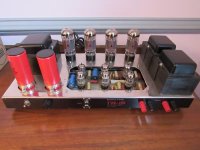 TVA-10 top cover-I.jpg88.9 KB · Views: 244
TVA-10 top cover-I.jpg88.9 KB · Views: 244 -
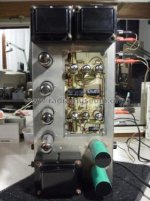 TVA-10 top cover-II.jpg21 KB · Views: 210
TVA-10 top cover-II.jpg21 KB · Views: 210 -
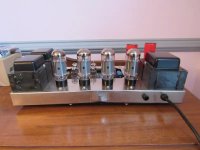 TVA-10 top cover-III.jpg74.7 KB · Views: 213
TVA-10 top cover-III.jpg74.7 KB · Views: 213 -
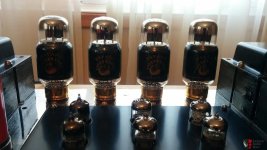 TVA-10 top cover-IV.jpg71.2 KB · Views: 191
TVA-10 top cover-IV.jpg71.2 KB · Views: 191 -
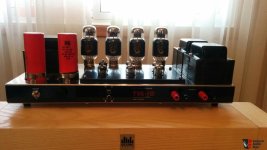 TVA-10 top cover-V.jpg53.5 KB · Views: 200
TVA-10 top cover-V.jpg53.5 KB · Views: 200 -
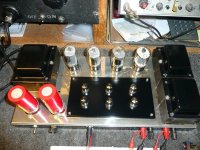 TVA-10 top cover-VI.jpg199.6 KB · Views: 194
TVA-10 top cover-VI.jpg199.6 KB · Views: 194 -
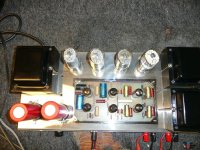 TVA-10 top cover-VII.jpg236.2 KB · Views: 209
TVA-10 top cover-VII.jpg236.2 KB · Views: 209 -
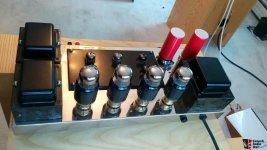 TVA-10 top cover-VIII.jpg68.6 KB · Views: 189
TVA-10 top cover-VIII.jpg68.6 KB · Views: 189 -
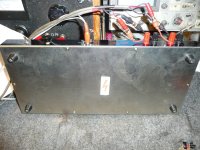 TVA-10 botton view.jpg222.9 KB · Views: 180
TVA-10 botton view.jpg222.9 KB · Views: 180 -
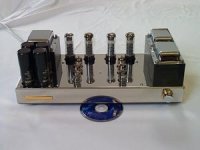 tva10 front volume contr..jpg13.9 KB · Views: 191
tva10 front volume contr..jpg13.9 KB · Views: 191 -
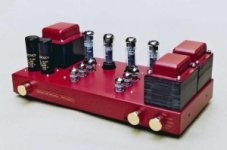 tva-10 Papworth.jpg15 KB · Views: 253
tva-10 Papworth.jpg15 KB · Views: 253 -
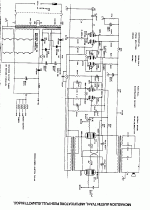 TVA-10 schematic-II.gif39.9 KB · Views: 327
TVA-10 schematic-II.gif39.9 KB · Views: 327 -
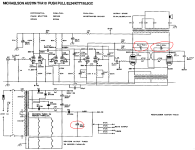 TVA-10 schematic.PNG156.9 KB · Views: 356
TVA-10 schematic.PNG156.9 KB · Views: 356 -
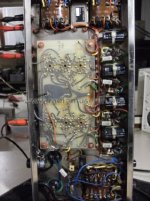 TVA-10 top cover-IIa.jpg25.3 KB · Views: 294
TVA-10 top cover-IIa.jpg25.3 KB · Views: 294
For Sale Bruel & Kjaer - Vintage Microphone Amplifier Type 2603
Brüel & Kjaer - Microphone Amplifier Type 2603
From the late 60s!
The 2603 is about 55 years old, it dates back to 1966~1969.
This preamp needs some care, but the overall condition is good, and fair given its age.
Was planning to restore it but never got to it so I'm letting it go.
ASKING PRICE € 1.250,00 + shipping
There are 6 or more tubes in the circuitry, and as far as I can tell most, if not all of these tubes are still available in case you need a replacement one day.
I have no idea of the condition of these tubes. Neither do I know if the capacitors need replacement. I never switched it on; it was sitting in my music studio as an eye catcher, waiting to be restored one day. All parts are there. And the unit looks well preserved, which is a good indicator.
I can give no guarantees. The unit is sold as is.
To know how it sounds, look on Youtube for:"Brüel & Kjaer Type 2603 vacuum tube preamp"
I collected several PDF's of this device and line of equipment, including the schematics etc.
I will happily send them to you (saves you some research)
Please note: this preamp does not work with regular XLR mics - although you could probably mod it to do so.
It does seem to work with line signals as a DI, as you can see from the linked video.
It accepts the following mic capsules from B&K: 4131, 4132, 4133, 4134 ..
Combine the above capsules with a B&K "Cathode Follower" type 2612, 2613, 2614, or 2615.
The above parts are available on Reverb and through other places and sellers.
---
The inputs and outputs require a type of B&K plug that is hard to find. Luckily these connections accept simple banana plugs too, which fit like a glove. The ins and outs are basically (unbalanced) line signals. One could easily fashion a set of adapter cables that go from banana plugs (male) to 1/4" jack (female) for day to day use.
---
Connections are as follows:
---
The overall gain is adjustable by the "Input Potentiometer" and "Meter Range" switch.
---
The power connector is a Nema 5-15R.
Adapters are available to regular IEC etc.
Alternatively you can connect a power cord directly using the screws adjacent to the inlet pins.
---
My location is Belgium. Items are shipped safe and secure with tracking etc.
Please contact me for a shipping quote for your specific location.
I'll be happy to make you a personal quote.
Have a nice day!
From the late 60s!
The 2603 is about 55 years old, it dates back to 1966~1969.
This preamp needs some care, but the overall condition is good, and fair given its age.
Was planning to restore it but never got to it so I'm letting it go.
ASKING PRICE € 1.250,00 + shipping
There are 6 or more tubes in the circuitry, and as far as I can tell most, if not all of these tubes are still available in case you need a replacement one day.
I have no idea of the condition of these tubes. Neither do I know if the capacitors need replacement. I never switched it on; it was sitting in my music studio as an eye catcher, waiting to be restored one day. All parts are there. And the unit looks well preserved, which is a good indicator.
- It could be non functioning, and require quite some work;
- It could require just a minimal check up and of you go.
I can give no guarantees. The unit is sold as is.
To know how it sounds, look on Youtube for:"Brüel & Kjaer Type 2603 vacuum tube preamp"
I collected several PDF's of this device and line of equipment, including the schematics etc.
I will happily send them to you (saves you some research)
Please note: this preamp does not work with regular XLR mics - although you could probably mod it to do so.
It does seem to work with line signals as a DI, as you can see from the linked video.
It accepts the following mic capsules from B&K: 4131, 4132, 4133, 4134 ..
Combine the above capsules with a B&K "Cathode Follower" type 2612, 2613, 2614, or 2615.
The above parts are available on Reverb and through other places and sellers.
---
The inputs and outputs require a type of B&K plug that is hard to find. Luckily these connections accept simple banana plugs too, which fit like a glove. The ins and outs are basically (unbalanced) line signals. One could easily fashion a set of adapter cables that go from banana plugs (male) to 1/4" jack (female) for day to day use.
---
Connections are as follows:
- "Amplifier input" = the main line input, which accepts a banana plug
- The small hole underneath this and other plugs is ground; accepting a banana plug as well
- "External Filter Input" = actually an output !! Clean signal from this out
- "Recorder" = allegedly this is a more fuzzy / slightly distorted output
---
The overall gain is adjustable by the "Input Potentiometer" and "Meter Range" switch.
---
The power connector is a Nema 5-15R.
Adapters are available to regular IEC etc.
Alternatively you can connect a power cord directly using the screws adjacent to the inlet pins.
---
My location is Belgium. Items are shipped safe and secure with tracking etc.
Please contact me for a shipping quote for your specific location.
I'll be happy to make you a personal quote.
Have a nice day!
Attachments
-
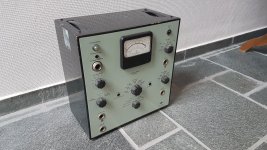 20170506_164546.jpg591.4 KB · Views: 153
20170506_164546.jpg591.4 KB · Views: 153 -
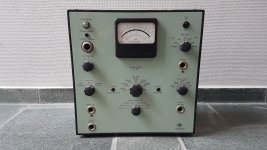 20170506_164620.jpg491.1 KB · Views: 130
20170506_164620.jpg491.1 KB · Views: 130 -
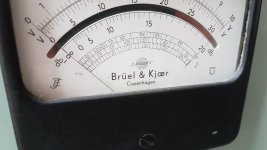 20170506_164600.jpg229.6 KB · Views: 118
20170506_164600.jpg229.6 KB · Views: 118 -
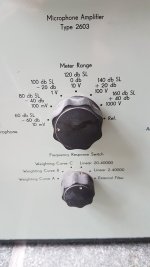 20170506_164610.jpg193.2 KB · Views: 105
20170506_164610.jpg193.2 KB · Views: 105 -
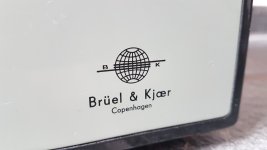 20170506_164629.jpg140.6 KB · Views: 107
20170506_164629.jpg140.6 KB · Views: 107 -
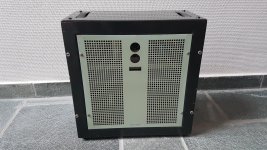 20170506_164655.jpg576.4 KB · Views: 115
20170506_164655.jpg576.4 KB · Views: 115 -
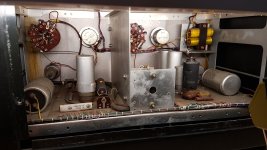 20170511_134604.jpg373.5 KB · Views: 128
20170511_134604.jpg373.5 KB · Views: 128 -
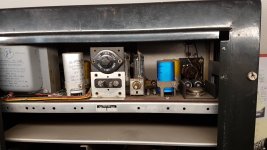 20170511_134718.jpg358 KB · Views: 141
20170511_134718.jpg358 KB · Views: 141 -
 20170511_134750.jpg374.9 KB · Views: 128
20170511_134750.jpg374.9 KB · Views: 128 -
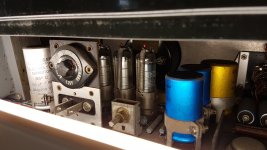 20170511_134805.jpg316.5 KB · Views: 130
20170511_134805.jpg316.5 KB · Views: 130 -
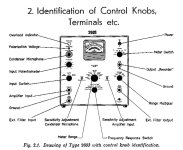 Screenshot 2023-07-05 093412.jpg139.2 KB · Views: 120
Screenshot 2023-07-05 093412.jpg139.2 KB · Views: 120 -
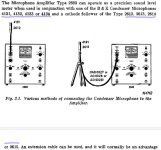 Screenshot 2023-07-05 093730.jpg79.8 KB · Views: 112
Screenshot 2023-07-05 093730.jpg79.8 KB · Views: 112 -
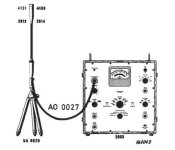 Screenshot 2023-07-05 092958.jpg79.6 KB · Views: 104
Screenshot 2023-07-05 092958.jpg79.6 KB · Views: 104 -
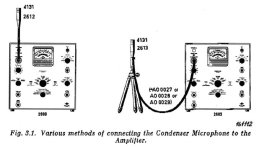 Screenshot 2023-07-05 093517.jpg44.1 KB · Views: 131
Screenshot 2023-07-05 093517.jpg44.1 KB · Views: 131 -
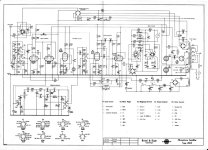 Schéma.jpg133.9 KB · Views: 178
Schéma.jpg133.9 KB · Views: 178 -
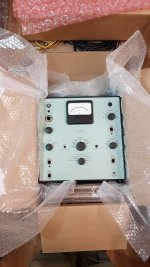 2603 ready to ship.jpg374.1 KB · Views: 156
2603 ready to ship.jpg374.1 KB · Views: 156
For Sale High Quality Speaker cables, with Viablue SC-4 cable and Speakon - 1 pair 1,5 m
Selling this excellent pair of Speaker Cables.
Custom built.
The cables are new, never used.
1,5 meters each.
With Viablue SC-4 speaker cable.
Comes with Neutrik Speakon plugs - these can be removed if you prefer open cable ends.
Including one handy Velcro binder per cable.
Price for the pair: € 70,00 + shipping.
Custom built.
The cables are new, never used.
1,5 meters each.
With Viablue SC-4 speaker cable.
Comes with Neutrik Speakon plugs - these can be removed if you prefer open cable ends.
Including one handy Velcro binder per cable.
Price for the pair: € 70,00 + shipping.
Attachments
Added mass method for VAS in DATS, differing results
- By jimk04
- Software Tools
- 2 Replies
I recently did some measurements on some B&W 8" drivers from one of their subwoofers. Using the added mass method I kept getting the message stating I hadn't added enough mass to lower Fs enough. I eventually plonked on a tape measure on top of the blue tac that I had run out of. I think this gave me an added mass of about 360g.
Voila, VAS measured and came out at 9.2 with an MMS of 101g.
I forgot to save this so I redid it a day or so later. Didn't add as much mass this time, can't remember exactly how much, but it have me a VAS of approx 12 and Mms in the 70g region.
Quite a change from my initial attemp and makes for different results in WinIsd obviously.
What do I need to for repeatable or more accurate results?
Voila, VAS measured and came out at 9.2 with an MMS of 101g.
I forgot to save this so I redid it a day or so later. Didn't add as much mass this time, can't remember exactly how much, but it have me a VAS of approx 12 and Mms in the 70g region.
Quite a change from my initial attemp and makes for different results in WinIsd obviously.
What do I need to for repeatable or more accurate results?
RemR P93 1969 Lithuanian Made Turntable
- By stubbs04
- Analogue Source
- 10 Replies
Well. Here is the inside of a 1969 Soviet era Turntable. It's a doozy😜
Apart from the unidentifiable cylinder that looks like it's been at the bottom of the ocean since 1969, the tone arm that seems to suddenly have a ton of tracking force, there is an unidentifiable contact switch hanging loose.
It's a brick.
Oh the turntable turns......kind of.
But it looks soooooo cool.
I could make this a quiz?
Apart from the unidentifiable cylinder that looks like it's been at the bottom of the ocean since 1969, the tone arm that seems to suddenly have a ton of tracking force, there is an unidentifiable contact switch hanging loose.
It's a brick.
Oh the turntable turns......kind of.
But it looks soooooo cool.
I could make this a quiz?
Attachments
XTZ A100D3 shutting down after power up.
- By matski
- Solid State
- 1 Replies
Hi all,
I acquired this amp three months ago, but with life getting in the way, I literally only powered it up last Monday afternoon. Essentially it runs through a start up procedure, the screen works, a fair bit of relay clicking and then it switches off. My own fault for not checking it sooner. I’m half decent with investigating and repairing, and even managed to get the schematics from XTZ. A lot of Chinese though and could be clearer. One 4700uf 63v cap on the power supply board had leaked, actually leaving a leg on the board. Lots of nasty glue everywhere but I’ve cleaned that away, checked the four main 12000uf caps, and they test within spec. I’ve replaced both 4700uf caps, sorted out a couple if dry joints and thought that obviously bad cap could be the issue. No. Found more dry joints on various voltage regulators and elsewhere. Still no joy. There is no response to any control input apart from power on. The overall build of this thing makes it worth the effort, but if anyone has any ideas they would be much appreciated. I’ve never seen an amp with so many screws, it’s depressing!
thanks
Mat
I acquired this amp three months ago, but with life getting in the way, I literally only powered it up last Monday afternoon. Essentially it runs through a start up procedure, the screen works, a fair bit of relay clicking and then it switches off. My own fault for not checking it sooner. I’m half decent with investigating and repairing, and even managed to get the schematics from XTZ. A lot of Chinese though and could be clearer. One 4700uf 63v cap on the power supply board had leaked, actually leaving a leg on the board. Lots of nasty glue everywhere but I’ve cleaned that away, checked the four main 12000uf caps, and they test within spec. I’ve replaced both 4700uf caps, sorted out a couple if dry joints and thought that obviously bad cap could be the issue. No. Found more dry joints on various voltage regulators and elsewhere. Still no joy. There is no response to any control input apart from power on. The overall build of this thing makes it worth the effort, but if anyone has any ideas they would be much appreciated. I’ve never seen an amp with so many screws, it’s depressing!
thanks
Mat
Attachments
Need help for bias adjusting for hybrid amplifier KORA ARIES
- By Lynyrd
- Tubes / Valves
- 15 Replies
Hello.
Need help for bias adjusting for hybrid amplifier KORA ARIES.
It's 2 resistors RV1 & RV2,but any ideas for value and test points.
Thank you.
Service manual
https://acrobat.adobe.com/id/urn:aa...mment_id=d334b95b-cf62-4fc5-8eb8-6fada25d6ce8
Need help for bias adjusting for hybrid amplifier KORA ARIES.
It's 2 resistors RV1 & RV2,but any ideas for value and test points.
Thank you.
Service manual
https://acrobat.adobe.com/id/urn:aa...mment_id=d334b95b-cf62-4fc5-8eb8-6fada25d6ce8
Old member of the site, but haven't introduced myself
- Introductions
- 1 Replies
Hi guys.
I have been a member for a very long time of this site, but haven't got into the introduction of myself.
Anyway, I reside in Denmark close to Copenhagen and enjoy good clean analog audio.
My system consists of a XTZ Class A-100, Dali Mentor 6 speaker and my precious Sony CDP-XA555ES.
Kind regards
Henrik Damtoft
I have been a member for a very long time of this site, but haven't got into the introduction of myself.
Anyway, I reside in Denmark close to Copenhagen and enjoy good clean analog audio.
My system consists of a XTZ Class A-100, Dali Mentor 6 speaker and my precious Sony CDP-XA555ES.
Kind regards
Henrik Damtoft
PPI A600.2 Open link
- By UserAbuser
- Car Audio
- 2 Replies
Hi All.
I have a PPI A600.2 in which R171 (obviously just a link) has gone open circuit.
I'm also not sure about the lump of solder on the edge of the board screw just below that.
Should I be concerned about either of these things ?
As yet I have not done any further testing.


I have a PPI A600.2 in which R171 (obviously just a link) has gone open circuit.
I'm also not sure about the lump of solder on the edge of the board screw just below that.
Should I be concerned about either of these things ?
As yet I have not done any further testing.
Load more
Projects by fanatics, for fanatics
Get answers and advice for everyone wanting to learn the art of audio.
Join the Community
507,634
Members
7,881,317
Messages
![PXL_20240503_194157856[1].jpg](/community/data/attachments/1214/1214147-223008c9d50d7e6ecc4d32caaccdcd72.jpg?hash=IjAIydUNfm)

